
The Eddy Awards


The Eddy Awards
Winning entries showcased creativity in effort to inform and persuade employees
By MA R GA RI DA CO RR E I A and CA R YL ANNE F R ANC I A401(k) serial loan takers. Pre-retirees unaware of the risk of being overly concentrated in equities. Young workers overwhelmed by student loan debt.
These are some of the groups that employers attempted to reach through work-
By DOUGLAS APPELLBlackRock Chairman and CEO Larry Fink’s latest annual letter to CEOs and clients called for the nancial equivalent of a moonshot to avert a looming U.S. retirement crisis.
“Maybe once a decade, the U.S. faces a problem so big and urgent that government and corporate leaders stop business as usual. They step out of their silos and sit
place retirement-plan educational campaigns that won Eddy Awards from Pensions & Investments this year.
At a ceremony held March 12 in Orlando, Fla., as part of its annual Dened Contribution East conference, P&I recognized 44 campaigns from employers in the private, public and nonpro t sectors and their service providers for their verve, creativity and singleminded focus on helping workers achieve
around the same table and nd a solution,” said Fink in his annual letter, released March 26.
“We need to do something similar for the retirement crisis,” Fink said. “America needs an organized, high-level effort to ensure that future generations can live out their nal years with dignity,” he added. Fink, whose views on industry trends carry added weight against the backdrop of
a digni ed retirement. Awards were given in ve categories: conversions/403(b) consolidations; nancial wellness; ongoing investment education, pre-retirement preparation and special projects.
This year’s top winners looked to address a wide swath of issues, ranging from debt reduction to the importance of naming 401(k) bene ciaries and the ben-

In the autumn of 2022, John L. Bowman, president of the Chartered Alternative Investment Analyst Association, met in a coffee shop in Singapore with Swee Chiang Chiam, managing director and head of total portfolio policy and allocation at Singapore sovereign wealth fund GIC, to discuss total portfolio approach, an alternative to traditional forms of strategic asset allocation, or SAA.

Over coffee, Bowman and Chiam discussed how a number of large institutional asset owners in New Zealand, Canada, Australia and Singapore — including GIC — had embraced total portfolio approach, or TPA, which “improves upon many of the long-entrenched practices of SAA when constructing their portfolios.”
That meeting would eventually lead to CAIA creating its seminal report “Innovation Unleashed: The Rise of Total Portfolio Approach” on March 19.
Essentially, Bowman noted, TPA eschews the traditional concepts of asset allocation and passive benchmarks in favor of picking the best investment ideas for the portfolio designed to meet a total return goal consistent with the fund’s actual purpose. TPA may be described as “one uni ed means of assessing
I EWED by JENN I FE R ABLAN
CalPERS CEO Marcie Frost, hailed as one of the most inuential women in institutional investing, talked to Pensions & Investments about America’s largest public pension system’s ongoing CIO search and its recent asset allocation increase to private equity and private credit — the darlings of the nancial market. The Sacramento-based pension fund has been searching for a new CIO to replace Nicole Musicco, who stepped down at the end of September. An announcement is expected any day now.
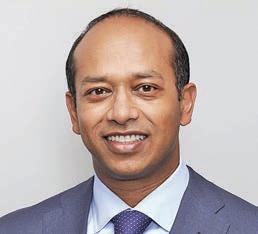

Alternatives
Quantitative managers are looking into arti cial intelligence and large language models, but so far many are skeptical.
Page 4
Special Report: Private Markets
Real estate debt may provide respectable returns, but the asset class also has signi cant drawbacks. Page 16
Private equity’s drops in valuations and distributions might start to impact pacing models for investors. Page 16
Lawmakers are concerned about private equity’s effects on the healthcare industry, and possible national security issues.
Page 17
Recent real estate investment darlings multifamily and warehouses could be in for a tough time. Page 19
According to Bain global private equity deal value plunged by 37% in 2023, while exit value dropped by 44%. There’s reason for optimism in 2024, however. Page 19
Washington
Auto IRA programs would help, say industry groups and experts, but the path to passing such legislation is unclear. Page 6
P&I still accepting late money manager surveys
Pensions & Investments is accepting late responses to the annual money managers survey. Firms managing U.S. institutional, tax-exempt assets are eligible to participate. Results will run June 10.
To request a survey or obtain further information, please contact Anthony Scuderi at ascuderi@pionline.com or 212-210-0140, or visit www.pionline. com/section/surveys
In the 18 months since IFM Investors was able to lure the high-pro le Luba Nikulina away from her 17-year career at Willis Towers Watson, it’s fair to say she’s built something of a super team.
Nikulina was brought in as the rst chief strategy of cer for the Australian superannuation fundowned infrastructure specialist in September 2022, tasked with developing the manager’s global strategy.
As chief strategy of cer, the idea “was to work on the evolution of IFM’s strategy — the organization that has 30 years of history, very strong credentials in infrastructure investing in particular, and quite a signi cant size of AUM with $150 billion,” Nikulina said in an exclusive interview. “But at the same time, it’s almost like the world’s best hidden secret in that it’s not actually that well-known outside Australia. My mission and objective at the time of joining was ... transforming the organization from an Australian asset manager with global ambitions to a global investment rm with a proud Australian heritage. This is what I’m essentially doing at the moment — quite a few of the new joiners are based in the Northern Hemisphere, and we are leveraging all the capabilities in Australia,” she said.
David Neal, CEO at IFM, said in an email that Nikulina hit the ground running for the fast-growing rm. “Stepping into the newly created role of chief strategy ofcer, Luba has been given a clear mandate to design and execute
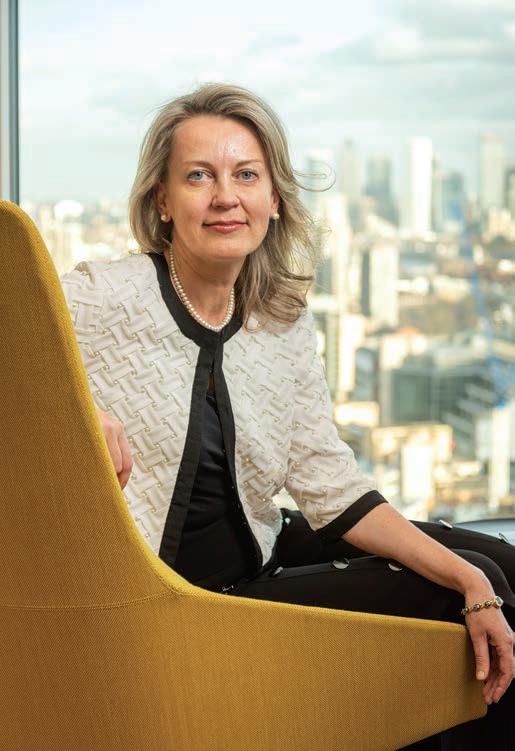
ply with the Texas Government Code Section 809, known popularly as the anti-ESG law.
Texas Comptroller Glenn Hegar in August 2022 included BlackRock on a list of 10 nancial companies he determined “boycott energy companies” as a result of that law.
By ROB KOZLOWSKITexas Permanent School Fund, Austin, terminated BlackRock from approximately $8.5 billion in assets as part of the state's push to punish ESG investing.
The $52.3 billion endowment informed BlackRock of the terminations in two March 19 letters from CEO/CIO Robert Borden, emailed by a spokeswoman.
The terminations affect a BlackRock international equity portfolio and an emerging markets equity separate account called the Navarro 1.
In a post on X (formerly Twitter), Aaron Kinsey, chairman of the state’s board of education who is also a member of the Permanent School Fund board of directors, said the relationship was terminated in order to com-

In a March 19 statement, BlackRock said: “Today’s unilateral and arbitrary decision by Board of Education Chair Aaron Kinsey jeopardizes Texas schools and the families who have bene ted from BlackRock’s consistent long-term outperformance for the Texas Permanent School Fund. The decision ignores our $120 billion investment in Texas public energy companies and de es expert advice. As a duciary, politics should never outweigh performance, especially for taxpayers.”
The termination of BlackRock from the
active emerging markets equity portfolio came just over a month after its board eliminated the emerging markets equity target allocation.
The endowment’s board of directors approved by a 5-1 vote the elimination of the asset class and other asset allocation changes at its Feb. 1 meeting, a webcast of the meeting shows.
Other changes included the elimination of targets of 2% each to commodities and emerging markets debt, and long Treasuries and the creation of new targets of 8% to private credit and 4% to bank loans.
In a March 19 news release, Tom Maynard, chairman of the Texas Permanent School Fund, said, “Companies pushing anti-Texas policies and woke indoctrination have no place in Texas public education, whether in the classroom or as investments in Texas Permanent School Fund. We will continue to defend our Texas values while generating more resources to support the school children of Texas.”
At Pensions & Investments we are committed to serving our audience where they want to engage with us and that continues to include our print publication (the newspaper), our website and newsletters, as well as a variety of live events and webinars that deliver thought leadership and best practices from industry experts. Our newsroom is committed to delivering thoughtful, analytical and accurate journalism to our readers daily. As a news publication serving the institutional investing industry, we are breaking news and providing the latest updates throughout each week. As such, we are focused on a digital- rst publishing approach in our
newsroom to deliver information in a timely fashion. While we will continue to deliver the print publication 18 times annually, we will be removing some of our regularly published features in print, but you’ll still be able to nd them all on www.pionline.com
As of our April 1, 2024, issue, we will no longer be publishing our monthly ESG roundup, monthly DC roundup, or At Deadline breaking news. All of these stories can be read on our website and are curated in our weekly ESG Digest, weekly DC Digest and P&I Daily newsletters. Additionally, we will no longer publish a

curation of Searches & Hires in the print publication. These mandates, searches and hires are all posted to our website as they are sourced and are part of our P&I Daily news subscription. You can sign up for our newsletters and get information about our various subscription offerings at www.pionline.com/ subscribe
We hope you will continue to engage with Pensions & Investments across all of our platforms, and I welcome your feedback on our continued evolution. It is our honor to have served this industry for 50 years and we look forward to the next 50 and beyond. n
After suffering through the long dominance of growth stocks, the value manager is seeing in ows
By DOUGLAS APPELLMehdi Mahmud took the helm of First Eagle Investment Management in 2016 with a mission: to diversify the value equity boutique’s business with strategies capable of delivering equity-like returns by other means.Now, after a prolonged period of dominance for U.S. megacap growth stocks that left value managers struggling to retain clients, Mahmud, in an interview, said First Eagle looks to be turning a corner.
Last year was the rm's second year in a row of positive net ows following heavy out ows over the three preceding years, something "I’m particularly proud of,” said Mahmud, who left his perch as chairman and CEO of Jennison Associates in early 2016 to become First Eagle’s
president and CEO.
The industry veteran was brought in by Blackstone and Corsair Capital Partners, after their 2015 purchase of a majority stake in First Eagle from TA Associates and First Eagle's family owners, to diversify and institutionalize a money management rm that, for all its strengths, had remained narrowly focused on value equities and the wealth management space.
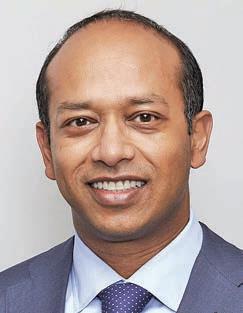
New York-based First Eagle reported $130.8 billion of assets under management as of Dec. 31.
Net in ows for 2023 came to about $200 million — “not a lot,” conceded Mahmud, but signicant nonetheless against the backdrop of a quick resumption of market dominance last year by megacap growth stocks following a sell-off in 2022 sparked by the start of a U.S. rate hiking cycle.By contrast, a number of value equity managers have suffered through ve years of negative ows, he noted.

DIVERSIFIED: Mehdi Mahmud said the move into private credit and municipal bonds helped drive First Eagle’s turnaround.
Mahmud credited First Eagle’s diversi cation strategy — including its move into private credit six years ago and last year’s push
The departure of four major money managers from the world’s largest investor-led initiative focused on climate change is worrying some European pension fund executives, who also reiterated their commitment to the cause.
Over the past six weeks, four of the top 20 money managers by assets under management left Climate Action 100+, an investor-led climate change-related engagement initiative with more than 700 signatories representing more than $68 trillion in total assets. They were State Street Global Advisors ($4.13 trillion), J.P. Morgan Asset
Management ($3.1 trillion), PIMCO ($1.86 trillion) and Invesco ($1.63 trillion). Also, BlackRock, the world’s largest money manager with $10 trillion in AUM, shifted its relationship with CA100+ to its international business.
Representatives at some of Europe’s largest pension funds told P&I that while the departures are disappointing, there remains an urgent need to focus on the impacts of climate change and to engage with the heaviest emitters.
“The departure of two major asset managers, J.P. Morgan Asset Management and State Street Global Advisors, from Climate Action 100+ and
SEE DEPARTURES ON PAGE 21 SEE
Aggressive monetary tightening by central banks, sti ed consumer spending and risks relating to the tightening U.S. money supply call for a cautious stance in the coming months, said Joe McDonnell, CIO at Border to Coast Pensions Partnership.
“We have only recently turned more cautious on the backdrop of a very strong performance in risk assets as markets are entrenched in this perfect Goldilocks scenario,” he said in emailed answers to questions from Pensions & Investments
“However, we continue to see downside risks to global growth as tighter liquidity begins to weigh more heavily on both consumer and corporate spending.”
And that’s certainly the case in Europe, which McDonnell said is “arguably already in a form of recession, especially in the more manufacturing-based economies such as Germany.”
The Leeds, England-based pool for 11 local authority pension funds that have a total about £60 billion ($77.1 billion) in assets, was responsible for £40.3 billion in assets as of March 31, 2023, invested across equities, debt and private markets for more than 1 million participants.
Markets are primarily occupied with interest rates, but the U.S. money supply amid Federal Reserve tightening is another risk on the horizon, he said. Al-
The S&P 500 continues to reach new highs as recession fears fade and optimism grows about the Federal Reserve cutting short-term interest rates. With nearly all companies reporting quarterly results, sales and earnings growth have been solid, and most have exceeded analyst expectations. Analysts expect certain sectors to hold back earnings growth at the start of this year but have a more optimistic outlook for the second half.
Beating estimates: With 496 companies reporting fourth-quarter results, 74% have beaten operating earning estimates. That’s in line with the 73% average going back to the start of 2013.
Results improve: The S&P 500 generated an aggregate 6.2% year-overyear sales growth and a 7% increase in operating earnings, with an operating margin of 11.1%. Consumer staples, information technology and healthcare had the largest sales growth.
Sales and earnings growth
Second-half pickup: Analysts expect earnings growth to accelerate in the second half, with the S&P 500 earnings per share to grow 3.7% and 7.1% in the rst and second quarters, respectively. They project this will accelerate to 20.5% and 19.9% in Q3 and Q4.
Earnings growth estimates
What recession? The number of companies citing “recession” in their latest earnings calls fell to 47, vs. 237 in the second quarter of 2022. At the start of the pandemic, 210 companies mentioned “recession.”
Companies citing “recession” on earnings calls

 By
LYDIA TOMKIW
By
LYDIA TOMKIW
Quantitative money managers are exploring how to apply generative arti cial intelligence and large language models in their day-to-day work, but many are skeptical about AI’s uses in the investment process to generate alpha.
Instead, mundane tasks are proving more fruitful, said panelists and
attendees at the Quant Strats conference held in New York on March 12.
The idea of AI completely taking over and the human touch becoming irrelevant is doubtful, said Stacie Mintz, head of quantitative equity at PGIM Quantitative Solutions.
“Human beings still create the models, so even though we use models for stock selections and portfolio construction, the humans are the ones creating and evolving the models,” she said.
Investors will always be faced with situations and geopolitical risks where models need thoughtful adjustments, Mintz added.
“Really with any new technology, you need to understand what the potential pitfalls are, and as investors we are always going to come into situations that we’ve never seen before, so Covid is a great example,” she said.
AI needs human supervision, argued Tim Liu, a senior researcher at Neo Ivy Capital, a quantitative hedge fund.
“In my view, AI has some potential, but it’s not the key for everything,” he said.







Liu said it would take 100% condence that generative AI can replicate humans for it revolutionize investment decision-making and replace humans. “I don’t see the day coming any time soon,” he added.
A true leap could come if something closer to arti cial general intelligence – a eld of AI that is attempting to create software with human cognitive abilities so it can solve unfamiliar tasks – develops, said Gordon Ritter, CIO of Ritter Alpha, an investment advisor that runs systematic absolute-return strategies.
Currently, quants need to be cautious around using AI to generate trading models, said Michael Weinberg, an adjunct professor of nance and economics at the Columbia Business School, and special advisor to the Tokyo University of Science endowment.

Pension funds are rethinking their impact on participants’ lives, especially with an aging population. They’re exploring innovative approaches to retirement,
the crucial role pensions play. Recent studies highlight how pensions benefit society




“You have to be uber careful that you’re not over tting or looking at spurious correlations or relationships,” he said. “It could be that that the AI or LLM nds a relationship where certain stocks or industries or markets outperform or underperform while something else happens, but that could be entirely coincidental, not causal.”
Weinberg uses a checklist with over 80 different data points to ascertain what alternatives managers are really doing with arti cial intelligence.
For now, generative AI is great at automating routine tasks, he added.
Many quants are seeing applications and productivity gains outside of the investing process.


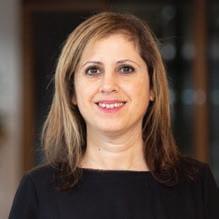



“[Y]ou can automate a lot of the simpler stuff, like docs and legal… and operations. I think there is tremendous and obvious cost savings and productivity that can be enhanced on in the middle and back of ce,” said Milind Sharma, CEO at hedge fund QuantZ Capital Management.
Yesim Tokat-Acikel, a managing director and portfolio manager at Principal Asset Management, said she is nding generative AI use cases experimenting with automating and writing responses for requests for proposals, creating initial drafts of documents and commentary.
Using a large language model that costs $30 a month is helpful for automation work and debugging code and can replace some work that was previously done by entry-level quants or software engineers, said Revant Nayar, CIO at hedge fund FMI Technologies.
But for alpha generation, generative AI shouldn’t have an impact, Nayar said. It’s an “extreme statement” he said, but with everyone having access to models, a consensus opinion will take hold. The best quants will be able to think of things LLMs have not, he added.















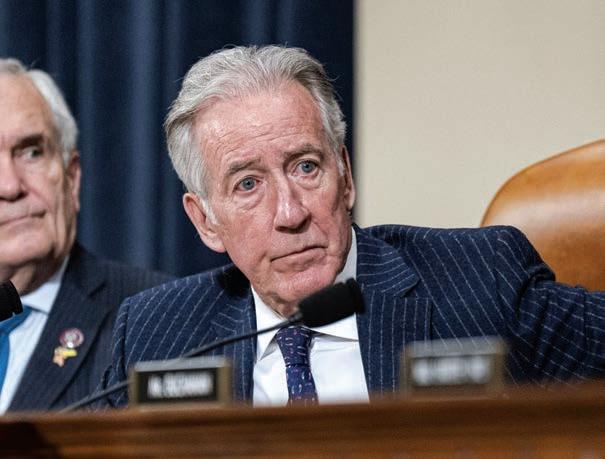



Enacting federal legislation that builds on state automatic IRA programs would bolster retirement savings in America, industry groups and experts said, but the path to passing
such legislation is unclear.
In February, Rep. Richard Neal, D-Mass., reintroduced the Automatic IRA Act of 2024, which would require businesses with 10 or more employees not currently offering a retirement plan to automatically enroll their workers in IRAs or 401(k)type plans.
“My plan here and the goal is to enhance retirement savings for people at the lower end of (the) economic spectrum and/or those who are in

a workplace where a retirement plan is not offered,” said Neal, ranking member of the House Ways and Means Committee, in a Pensions & Investments interview last month.
Speci cally, the bill requires that covered employers set up a 401(k)type plan or facilitate auto IRAs, with both default contribution rates starting at 6%. The bill is intended to “build on, expand upon, and protect the growing state-facilitated automatic IRA retirement saving programs,” according to a bill summary from the Ways and Means Committee Democrats.
As of Jan. 1, 19 states have enacted state-facilitated retirement programs, 15 of which are auto IRA programs, according to Georgetown University’s Center for Retirement Initiatives.
“We're seeing more and more states moving forward with these requirements anyway, so isn't it better to have some sort of federal, uniform solution than having 50 different states doing 50 different things?” said Melissa Kahn, managing director of retirement policy for the dened contribution team at State Street Global Advisors.
Douglas Magnolia, chief customer of cer and president of state savings at Vestwell, a record-keeping platform powering auto IRA programs in Oregon, Maryland and Connecticut, among others, also highlighted the growth of state-sponsored retirement programs, noting that such programs “are proving to everybody that (they work).”








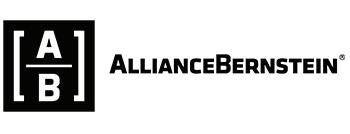



“If this bill kind of helps cement those programs for those states and then creates an option, seemingly nationally, for people to be able to do that, I don't know how that's a bad thing,” Magnolia said.
However, Republicans did not support Neal’s bill in the past over concerns of a “mandate,” and sources noted that the bill may struggle to garner support, especially in an election year, when Congress is less likely to pass legislation.
“Realistically, I think that it's great that (Neal) reintroduced (this bill.) I think the conversation needs to continue,” Kahn said. “I think this is probably a topic for next year when we have a new Congress, depending on who the administration is.”
Despite the progress that’s been made, the retirement system is still not where it needs to be, according to Kahn.
“Now that we're in a world where de ned bene t plans are really a dinosaur, I think that we need to gure out how to make sure that people can plan and pay for their own retirement,” she said, which can be through de ned contribution plans or IRAs, as the bill calls for.
Applying to plan years beginning after Dec. 31, 2026, the bill stipulates that employers with 10 or more workers must set up 401(k)-type plans or facilitate auto IRAs, both with automatic enrollment and a default contribution rate of 6%.
For 401(k)-type plans, the contribution rate would automatically increase by 1 percentage point each

Governance, implementation, specialist manager access, market complexity, lack of expertise or bandwidth: a host of reasons are behind the diversity in types of institutions and the growth in scale of capital pools that are engaging OCIOs, or outsourced chief investment officers. With allocators focused on alpha-generating sources of return as they look ahead to the next decade — particularly via alternatives and private markets — OCIOs are bringing their discretionary expertise and specialized relationships with asset managers to the forefront. Many OCIOs are delivering flexible and custom mandates, tailored to specific allocator segments and even specific institutions’ needs within each segment, which is further encouraging industry growth. OCIO performance measurement, value-added services and education, and innovative methods of accessing asset managers are all top of mind for asset owners as they partner with OCIOs today.
Our panel of OCIO experts shares the latest in types of mandates, current priorities for different allocator types, and the greater efficiencies being delivered through new data and technology that, while significant, will not replace the more nuanced collaborative relationship.
Read all the articles and access exclusive sponsor content online:
pionline.com/ocio-report2024





Sponsored by:

How did a physicist with a background in hard sciences and space research end up in asset management?
George N. Patterson, managing director and the CIO for PGIM's Quantitative Solutions group, began his career three decades ago at a place one does not normally associate with portfolio management and nance — NASA.
After securing physics degrees from both the Massachusetts Institute of Technology and Boston University, Patterson went to work at NASA's Jet Propulsion Laboratory in Pasadena, Calif. for about two years as a technical staff member.
“It was great working at JPL and I enjoyed the research, but at some point I decided that I didn't want to spend my whole career in a government lab and wanted to use my analytical skills somewhere else,” he said. “After some soul-searching, I thought about becoming an actuary. However, I crossed paths with members of Barclays Global Investors at a research luncheon and ended up working there in various capacities for more than a decade. While more traditional asset management rms looked at me as if I had three eyes in my head during the interview process, BGI didn't. BGI researchers had diverse backgrounds including nance, economics, math, physics and computer science. For me, it was the
perfect t.”
Patterson eventually rose to become a portfolio manager at BGI on the market-neutral team despite his nontraditional background.
At both NASA and Barclays, Patterson said, rigorous research is required — the main difference is at one place one is studying space and planetary science, while the other is focused on analyzing markets and asset pricing.
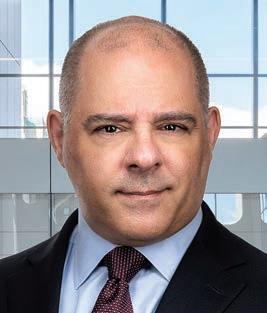
Following his 10-year tenure at Barclays, Patterson has held senior positions at Menta Capital, BMO Global Asset Management and Axioma Inc., before joining PGIM in October 2017.
Patterson said he expects to see more people with science, tech, mathematics and physics backgrounds enter asset management — particularly at quant shops where their knowledge and analytical skills would t in very well.
However, Patterson pointed out a crucial difference between studying space and studying markets: “There are no equations of motion in nancial markets, and you need to take a statistical viewpoint,” he said. “But in physics, the fundamental laws never change. You never have a bad year for gravity or quantum mechanics, it's always the same.”
On that basis, he thinks the nancial markets are more interesting.
PALASH GHOSHThe SPARK Institute and LIMRA have joined forces to ght nancial fraud within the retirement services industry, seeking to enhance consumer education as well to develop best-practices guidelines for fraud prevention.
“The evolving landscape of nancial fraud demands a proactive and collaborative response from the industry,” Tim Rouse, executive director of the SPARK Institute, said in a Feb. 28 news release. “Our partnership with LIMRA will strengthen the industry's collective defenses, protect the interests of our members and ensure the long-term security of retirement assets for the millions of American workers that depend on us.”
The SPARK Institute represents service providers, investment managers, banks, mutual fund companies, insurance companies, third-party administrators, trade clearing rms, and bene ts

Tara Roth isn’t trying to replace the patriarchy with a matriarchy, but the president of the Goldhirsh Foundation does hope that naming an all-female investment committee will turn heads.
“What I want is parity,” Roth said. “But I think sometimes you need to put something in front of someone’s face and jostle a little bit the conventional wisdom and thinking.”
The approximately $60 million foundation named Shana Barghouti, co-chief investment of cer at ReMY Investors; Natasha Case, cofounder of Coolhaus Ice Cream; Celestine Schnugg, founding managing partner of Boom Capital; and Ruth Wernig, former chief investment of cer of The California Endowment, to its investment committee last week. The team takes over from an all-male investment committee that served for 10 years and has ful lled its mandate, she said.
The new committee is part of a broader shift for the Goldhirsch Foundation’s endowment that supports the organization’s broad mission of maximizing human potential and wellness with a large portion of its grantmaking taking place in

consultants. LIMRA is an insurance industry research organization.
According to the news release, the collaboration features four fraud- ghting strategies: A fraud prevention benchmarking study that will be created during the rst half of 2024 to “provide industry participants with valuable insights into the current state of fraud prevention practices” and to serve “as a foundation for identifying best practices, gaps in existing strategies and areas for improvement within the sector.”
Educational resources targeting plan sponsors and participants. “By enhancing awareness and understanding of emerging fraud threats, this initiative aims to empower
individuals and organizations to proactively safeguard against fraudulent activities.”
The use of industry platforms to share fraud incident and fraud threat intelligence information. This “will enable organizations to stay ahead of evolving fraud tactics and enhance their collective ability to detect and prevent fraudulent activities.”
An annual nancial services fraud and data security summit to “bring together industry experts, thought leaders and other key stakeholders to share insights, discuss emerging trends and collaborate on innovative solutions to more effectively combat fraud.”
— ROBERT STEYERLos Angeles. In 2023, the foundation’s investing became 100% mission-aligned, Roth said.
Roth hopes that others will follow the foundation’s lead, but says the decision to name an all-women committee was not a diversity, equity and inclusion play.
“This is about nding excellent people with speci c expertise in different functional and organizational arenas,” she said.
In fact, Roth has eschewed environmental, social and governance investing labels and thinks there is a much more expansive way of looking at investing with values and intentions.
With all-male investment committees being the norm for so long, Roth argues that in order to survive and thrive, the foundation needs to think differently.
“It's a little bit about stepping back and looking at the framework of, 'just because that's the way business has been done,' does not mean that that's the way business should proceed to be done,” she said.
LYDIA TOMKIWSovereign wealth funds are doing more to address climate change in their portfolios, according to a survey released March 14 by the International Forum of Sovereign Wealth Funds and the One Planet Sovereign Wealth Fund Network.
“Since 2020, the survey results have revealed sovereign wealth funds’ rapid progress in making their portfolios more resilient to the impact of climate change by measuring and monitoring their climate impact and looking to mitigate it,” the survey report said.
The 34 respondents to the fourth annual survey of IFSWF and OPSWF members represent 40% of the world’s 95 sovereign wealth funds, and 90% of the roughly $7 trillion in assets under management, according to IFSWF’s database.
The latest survey found more than one third of them carbon footprinting their portfolios in 2023, up from 18.5% in 2022. All but three of them see addressing the effects of climate change as
consistent with their investment mandate, with 68% saying it would improve long-term returns.
The percentage of sovereign wealth funds with a speci c mandate to address climate change increased to 29% from 14% in 2022.
Last year also brought another surge in sovereign wealth funds adopting climate change analytical tools, “showing how government investors were taking action and materially changing their processes, policies and portfolios,” the report said.
The latest look also found sovereign wealth funds expanding beyond unlisted assets like private equity and real estate to listed markets including xed income and hedge funds. While private equity is still the preferred asset class for sovereign wealth funds’ climate change strategy, with 66.7% of respondents following that strategy, 53% now select listed equities for climate-related themes, up from 33.3% in 2022, the report said.
Pooled employer plans are gaining traction across the defined contribution industry as a solution that can deliver a high-quality retirement program to employees with lower overall costs, a broader range of plan features and more robust compliance processes — versus managing a standalone DC plan. PEPs today are seeing more innovation and flexibility in approach, leading all types of DC plans to examine them more closely. This Guide covers:
















Japan’s venture and private markets ecosystems are ready for U.S. institutions
As Japan anticipates a shift in monetary policy through potential interest rate hikes, the spotlight is intensifying not only on its public equity market but also on its less-explored venture and growth capital sectors. The upcoming policy pivot is expected to reinvigorate the Japanese public equity market, but amid a backdrop of strong corporate earnings and strategic central bank maneuvers, private markets also stand to bene t. U.S. institutional investors and consultants, who are increasingly allocating a larger share of capital to private markets, are assessing the Japanese startup industry given it presents an attractive combination of innovative growth opportunities, macroeconomic resilience, and it is viewed as a potential safe haven from geopolitical issues affecting other countries.

of either early stage or buyout funds. Thus, there is a signi cant gap in the middle-market, particularly with regards to managers focused on growth capital opportunities. Some Japanese deep tech startups are in the post-proof-ofconcept phase, as such they are often signi cantly undervalued compared to their peers in other developed economies. This discrepancy presents a strategic opportunity for investors to enter the market at favorable valuations.
The Japanese government is actively working to improve the venture capital landscape, as demonstrated by an ambitious plan to boost startup investments to approximately ¥10 trillion ($68 billion) by 2027. This effort re ects a strong commitment to fostering a vibrant entrepreneurial ecosystem.
For U.S. investors, Japan’s venture and growth capital market has historically been an underexplored area for allocations. This is no surprise when Japan’s burgeoning venture ecosystem is compared with that of the U.S. and China: total startup funding in Japan currently amounts to only about $6 billion. However, this is 10 times what it was in 2013.
As a result of this ongoing maturation, Japan’s startup industry has carved out a leading position and competitive edge in certain deep technology sectors, such as robotics. Some Japanese deep tech companies, which are focused on providing tech solutions based on substantial scienti c and/or engineering challenges, are ripe for global growth yet require signi cant amounts of capital if they are to scale to a size where they can compete meaningfully on the global stage.
The Japanese private markets industry is notably barbelled, containing mostly a mixture
Beyond the bustling metropolis of Tokyo, regional hubs like Fukuoka are emerging as key players in Japan’s venture scene, buoyed by their strategic locations (Fukuoka is a port city with access to Singapore, Seoul, Taiwan and Hong Kong) and encouraged by the historical successes of corporate behemoths such as Toyota and Nintendo, which hail from outside the capital. This geographic diversi cation within Japan enriches the venture capital landscape, offering a broader spectrum of investment opportunities than most investors are currently aware.
global business acumen into Japanese startups, enhancing their appeal to international investors. This cross-pollination of expertise is pivotal in elevating the credibility and global reach of Japanese startups, making them more enticing investment targets.
U.S. institutional investors, known for their strong demand for private markets, are increasingly recognizing Japan’s venture capital ecosystem as a burgeoning subasset class offering both diversi cation and the potential for attractive returns. This interest signi es a strategic pivot towards exploring new avenues within the private markets asset class, where Japan’s unique positioning and innovative sectors present an untapped opportunity for growth and investment.
As Japan’s venture ecosystem continues to mature, it beckons as a strategic opportunity for U.S. institutions looking to diversify their portfolios.
A key tailwind for the space is the in ux of global professionals from investment banking and private equity into the Japanese venture ecosystem. This net brain gain is injecting
A key metric for investors, the distribution to paid-in capital ratio (or DPI), indicates a healthy Japanese market capable of delivering robust returns, competitive with those in the U.S. and China. Japan has begun to overcome previous challenges of aligning investment sizes with startup needs, making the market increasingly accessible to foreign capital. As Japan’s venture ecosystem continues to mature, it beckons as a strategic opportunity for U.S. institutions looking to diversify their portfolios and capitalize on deep tech innovation in the region. This
OTHER VIEWS JEREMY KATZEFF
In the hunt for greater yields, diversi cation and returns, traditional asset managers are increasingly setting their sights on acquiring private markets specialists — particularly those with proven expertise in navigating complex and hard-to-access areas like infrastructure.

Take BlackRock's acquisition of Global Infrastructure Partners in January, for instance, which once again makes BlackRock the agent of change in the asset management industry. Once the $12.5 billion deal closes — slated for this summer — BlackRock will become the world's second-largest manager of private infrastructure assets, controlling an estimated $150 billion in infrastructure holdings ranging from the U.S. lique ed natural gas export market to airports in England and Australia.
While the deal is by no means the rst of its kind, signs are already emerging that it will accelerate the consolidation drive playing out in the asset management space. Indeed, last month, Europe's largest asset manager, Amundi, struck a multibillion-euro deal to acquire private markets specialist Alpha Associates, becoming the latest mainstream investment group to target the fast-growing alternatives space. And there can be little doubt over the growth opportunity posed by private markets. According to data provider Preqin, the overall private capital industry is forecast to grow to about $18 trillion by 2027 — a considerable leap
from about $10 trillion in 2021.
Of course, no one is suggesting that this foray into private markets is without risk. There have been countless analyses on the dangers presented by longer lock-up periods, for example. However, there has been far too little attention paid by market participants to the various operational complexities sure to emerge as the work ows surrounding public and private investing converge — particularly surrounding data management. And in the increasingly competitive and data-dependent landscape of investment management, asset managers can ill afford to overlook this element as they seek out private market fund acquisitions. It is paramount asset managers consider the investment process for private markets investment — namely due diligence, investment and valuation — through a data lens.
New batch of challenges
Performing due diligence on prospective investments — be it a business or infrastructure project — is one of the most data-intensive processes for investors, particularly those operating in private markets. Due to the nature of private markets, which as the name suggests are private, much of the key information required to build a good understanding of a prospect is not typically available in the public domain. Asset managers must request and organize the data themselves — much of which arrives in unstandardized formats.
It is paramount asset managers consider the investment process for private markets investment — namely due diligence, investment and valuation — through a data lens.
The sheer volume and variety of data required to complete effective due diligence exacerbates the challenge from a resource-allocation perspective. While market data providers have created speci c due-diligence offerings to combat this — some of which specialize in private markets — rms must carefully consider how these may interact with their existing data operating models, especially if they are mainly geared towards public investments.
Once due diligence is complete and a term sheet is signed, rms then face the challenge of keeping track of the capital committed, along with the capital drawn against that investment. As rms integrate private market assets into their wider investment portfolio, this will become increasingly complex. Most of the time, private market capital calls arrive via emailed PDF attachments, or even, in some cases, via fax which is hard to believe in 2024. For rms trying to track both public and private capital calls, sifting through and unifying this data will require signi cant legwork.
The task of accurately valuing assets presents another data dilemma, for several key reasons. Private assets are not markedto-market as often as public investments, so they can be subjective and dif cult to determine. Consider, for instance, the complexity of valuing a major infrastructure project such as the development of a new airport. Such projects typically possess long lifespans with highly diverse and convoluted cash ow patterns. Accurately forecasting future cash ows — which is fundamental to asset valuation — over such extended periods can be extremely tough, requiring careful analysis of factors like economic trends, regulation, maintenance costs and potential risks. Of course, all of these factors rely on effectively analyzing and managing a vast variety of data. For most traditional asset managers, the types of data they may have to scrutinize will be entirely new, and subsequently present a fresh set of challenges.
These examples highlight relative luxuries of investment data for public markets. It serves as a reminder to go into private markets deals with eyes wide open. If a private market business acquisition is to be a success, the parent company must be able to integrate and utilize the data from the new company. An inability to integrate could add signi cant costs after the acquisition if the complex data puzzle is assembled haphazardly.
While the opportunity posed by alternative assets is compelling, asset managers should ensure they possess the necessary data infrastructure to accommodate a set of assets that behaves very differently from the likes of publicly traded stocks and bonds. Indeed, if they are to successfully capitalize on the opportunities on offer in the private markets arena, data must be at the heart of the strategy going into a deal — not a mere afterthought. n
This content represents the views of the author. It was submitted and edited under Pensions & Investments guidelines but is not a product of P&I’s editorial team.
To mitigate climate risks, the global economy needs to decarbonize to reach net zero by 2050. Large scale and rapid decarbonization of the major emitting sectors (power, buildings, transportation, etc.) will require huge numbers of wind turbines, solar panels, electric vehicles and storage batteries that will require water, energy, rare earth elements and critical metals to produce, creating more emissions from production. The decarbonization pathway is likely to be bumpy and dirty.
Some asset owners started to shift their attention from the complexity of decarbonizing the economy to decarbonizing portfolios. Decarbonizing portfolios often involves shifting to securities with lower carbon emissions, and it may involve divesting from entire sectors. This approach is marketed as a way to make portfolios more resilient to climate change risks. However, simply having exposure to companies with lower carbon emissions is not equivalent to reducing the portfolio's exposure to climate risk. Whether a company has higher or lower relative carbon emissions today tells us little about how vulnerable or resilient their business model will be to climate-related


risks in the future. Portfolio decarbonization alone isn't enough to mitigate against climate risks.
The dislocations and inef ciencies that will come from decarbonizing the economy can present investment managers with opportunities to outperform the market. Investors can generate excess returns if they skillfully use information about climate-related costs and opportunities as part of their overall investment process, balancing climate-related factors with other risks and opportunities. Such strategies may include
investments in carbon-intensive securities where active managers have considered the physical and transition risks from climate change. There's no free or perfect "hedge" to protect portfolios from complex climate risk.
Some asset owners have confusingly blurred the line between their efforts to decarbonize the portfolio and efforts to decarbonize the real global economy. Asset owners shouldn't kid themselves into thinking these are equivalent. Selling carbon-intensive securities in the secondary market doesn't mean the securities will emit fewer greenhouse gases. It just means that someone else will own those securities. Some (but not all) investors seek an environmental impact alongside nancial returns (otherwise known as "impact" investors), and they should use their capital and stewardship to in uence the behavior of companies — that is, providing additional capital or engagement to help companies innovate and develop climate solutions faster, or to reduce emissions. There are investment strategies that do this, and they tend to look very different from simple portfolio decarbonization. For example, buying stock in a large, publicly traded electric vehicle (EV) company — even if you
buy a lot — is unlikely to change the number of EVs on the road. To help decarbonize the real economy, an investor can provide venture capital nancing to an EV startup to accelerate both its growth and the adoption of EVs. Portfolio decarbonization isn't the same as decarbonizing the economy.
Too many investors are decarbonizing portfolios for the wrong reasons, while some conventional investors (purely return seeking) avoid sustainable-themed investments, thinking they cannot make money. The narrative on climate change and investing has been oversimpli ed so much that many investors are behaving in ways counter to their goals. Instead of naively assuming all investments with low carbon emissions support climate objectives, or none generate strong returns, investors are better served by careful analysis of how each investment accomplishes their objectives. Decarbonizing the economy presents opportunities for both conventional and impact investors. n
This content represents the views of the author. It was submitted and edited under Pensions & Investments guidelines but is not a product of P&I’s editorial team.


CONTINUED FROM PAGE 1
e ts of saving on a Roth or after-tax basis.
Some campaigns were comprehensive, multimedia initiatives. Others were fashioned as long-term nancial wellness “challenges” or events that urged participants to take actions to improve their retirement readiness. Still others took highly innovative approaches, such as using birthdays and job promotions as “fresh start” triggers to nudge participants to reset their retirement goals.
Descriptions of some of the top-winning campaigns are organized by category below:
Two of the top three P&I Eddy Award winners in the nancial wellness category tackled ways in which to help plan participants reduce their debt.
Global investment management rm Conning & Co. (record keeper Empower), for example, grabbed rst place for corporate plans with less than 1,000 participants for a campaign focused on participants it identi ed as “serial loan takers” — those who soon or immediately after paying off a loan against their 401(k) accounts take another loan.
“We wanted them to be aware of the downside to doing that,” said Greg Nickett, vice president of Human Resources at Conning, of participants who perpetually borrow from their 401(k) accounts.
The campaign consisted of a simple communication that cautioned the serial loan takers to “think twice before borrowing from their 401(k),” emphasizing the drawbacks of doing so.

“While you’re repaying your loan, you may not be able to contribute as much to the 401(k) plan, which could affect your long-term nancial goals,” Conning reminded loan takers in its $143 million 401(k) plan.
The targeted messaging worked. In 2022, the number of new loans dropped to nine, down 50% from 19 in 2021. The total loan amounts also fell, plunging to $224,000 from $443,000.
Participants clearly got the message, Nickett said. “You don’t want to be out of the market because you took a loan when there’s a rally,” he said.
The University of Colorado (TIAA-CREF) was also recognized for a campaign around the related issue of student loans, nabbing a rstplace Eddy Award for public plans with more than 5,000 participants. The public university employed Savi, a web-based service that helps borrowers navigate the federal government’s Public Service Loan Forgiveness Program for
individuals employed in the public sector and nonpro t organizations.


“It seemed like this would be a really good bene t for our employees,” said RyAnne Scott, director of Communications and Outreach, Employee Services, at the University of Colorado, noting that its faculty and staff struggled with student loan debt.
“It would save them money and encourage them to value their work at the university more,” she said.
The university’s “Conquer Your Debt” promotional campaign featured a webpage, employee portal, webinars, posters and email communications, using video game imagery to reinforce the idea that Savi could help participants reduce their student debt. The university offers both a $4.2 billion 401(a) plan and a $1.4 billion 403(b) plan.
As a result of the campaign, borrowers lowered their debt by an average of $168 a month,
Financial wellness winners: Conning & Co. (top left) warned employees of the dangers of taking excessive loans out on their 401(k)s, while the University of Colorado (above) emplored employees to ‘Conquer Your Debt.’ At left, Brakebush Brothers encouraged employees to take part in the company’s wellness challenge.
with the average forgiveness per borrower totaling $73,061.
In one case, an employee received $513,000 in forgiveness, “the highest forgiveness amount they’ve ever seen at Savi,” Scott said.
Brakebush Brothers (Francis) tackled a different issue with its July Wellness Challenge campaign, which tied for rst place with Alliant Energy (Empower) for corporate plans with 1,000 to 5,000 participants. The Wisconsin-based processor of chicken products wanted to engage more participants in the company-paid one-on-one nancial advice services it provided its workforce through retirement
plan consulting rm Francis.
While many workers met one-on-one with the nancial advisers, they tended to be the same workers year over year, said Alexandra Allen, corporate manager of Wellness at Brakebush.
“We were trying to capture people who maybe never have tried Francis,” she said.
As part of the July Wellness Challenge campaign, participants in the company’s $117 million 401(k) plan were required to meet with Francis nancial advisers and update their 401(k) and life insurance bene ciary elections. They also had to complete 15 voluntary, easyto-complete tasks, such as saying thank you to a co-worker or not eating junk food for a day.
As a result of the month-long effort, Brakebush boosted the number of participants who updated their bene ciary elections, with 27% of challenge participants ful lling the task.
The company also saw a strong uptick in the number of participants meeting with a nancial planner. For the 12-month period ended Aug. 31, 2023, 237 participants met with Francis advisers, up 34% from 177 the year before.
Those who met with planners reported an overwhelming positive experience, Allen said, adding that those who completed a satisfaction survey gave Francis high scores.
More than 4 in 5 (83%) indicated that the advice helped their nancial wellness with the remaining reporting that “it’s too soon to tell,” Allen said.
Top Eddy Award-winning campaigns in the ongoing investment education category covered everything from motivating participants to contribute more to their retirement savings accounts to educating them about changes to their workplace savings plans.
Industrial equipment supplier Applied Industrial Technologies (Principal Financial Group), a rst-place winner for corporate plans with more than 1,000 participants, for example, was recognized for using “fresh start framing” to encourage the participants in its $720 million 401(k) plan to save more in the plan and to at least save enough to maximize the company’s matching contribution.
The company matches 50% of a participant’s contribution, up to 6% of pay, for a total maximum contribution of 3%.
The company’s used participants’ birthdays and pay raises and promotions as triggers or “fresh start dates” to nudge participants to save more.
“What we’re trying to do is have people maximize the match and have them save for retirement so that they are able to retire with 80% of their income,” said Kurt Loring, Applied’s chief human resources of cer. “We

CORPORATE
Fewer than 1,000 participants
First Place
Conning & Company
Service provider: Empower
CORPORATE
1,000 to 5,000 participants
First Place (tie)
Brakebush Brothers
Service provider: Francis
First Place (tie)
Alliant Energy
Service provider: Empower
CORPORATE
More than 5,000 participants
First Place
Polaris, Inc.
Service provider: Compass Financial
Partners & Fidelity
were trying to nd points of time or moments where individuals might to open to that conversation.”
Loring added that the targeted Happy Birthday notes made participants feel special.
“It’s not some random email that showed up,” he said. “It says Happy Birthday.”
The automatic Happy Birthday messages provided age-based guidance on how much they should have saved for retirement at their age. Individuals in their early 50s, for instance, received a message saying they should have saved 6.5 times their income by the time they’re 55.
The fresh start nudges were aimed at individuals who were saving less than 10% — the amount experts deemed necessary to hit an 80% income replacement in retirement — or had recently decreased their deferral rates or hadn’t updated them in a while.
Another top winner in the ongoing investment education category — construction specialty contractor Grazzini Brothers & Co. (Francis) — developed a campaign to educate participants about changes to the company’s $15 million 401(k) plan following the switch to a new record keeper. In addition to adding a target-date fund to the investment lineup, the company introduced a Roth 401(k) option and made nancial consultants available to participants.
“Because of all those big changes, I de nitely wanted to make sure that our employees knew what was going on,” said Amanda Eiynk, director of administration at Grazzini Brothers.
The company, which took rst place for corporate plans with fewer than 1,000 participants, developed a week-long program that focused on plan changes, with each day dedicated to different topics.
“I heard a lot of good feedback from employees both in person and anonymously that it was an enjoyable week,” Eiynk said of the 401(k) Week program. “It wasn’t overwhelming.”
One day was dedicated to the bene ts of saving on a Roth or after-tax basis. Because the company’s employee population is younger than it used to be, Grazzini Brothers thought it would be helpful to offer the workforce a Roth 401(k) option.
“We’ve had a lot of people start to retire, and so we’re bringing a lot more younger people in to ll those holes,” Eiynk said.
As a result of the campaign, 33% of participants are saving with Roth dollars, considerably more than the national average of 12%, Eiynk said.
The top Eddy-winning plan sponsors in the pre-retirement preparation category ad-
14
Second Place
Avangrid
Service provider: Fidelity Investments
PUBLIC
More than 5,000 participants
First Place
University of Colorado
Service provider: TIAA
GENERIC
First Place
T. Rowe Price
Second Place
Francis LLC
CORPORATE
Fewer than 1,000 participants
First Place
Grazzini Brothers & Company
Service provider: Francis
CORPORATE
More than 1,000 participants
First Place
Applied Industrial Technologies
Service provider: Principal Financial Group
Second Place
Fidelity National Financial
Service provider: Principal Financial Group
Third Place
Dematic Corp.
Service provider: Principal Financial Group
PUBLIC
More than 5,000 participants
First Place
Commonwealth of
Massachusetts
Service provider: Empower
GENERIC
First Place
J.P. Morgan Asset Management
Consolidations
CORPORATE
More than 5,000 participants
First Place
Westinghouse Electric
Service provider: Voya Financial
PUBLIC
More than 5,000 participants
First Place (tie)
Chicago Public Schools
Service provider: Corebridge Financial
First Place (tie)
Colorado State University
Service provider: Innovest Portfolio Solutions
CORPORATE
More than 5,000 participants
First Place (tie)
Southeastern Freight Lines
Service provider: T. Rowe Price
First Place (tie)
ADP TotalSource
Service provider: Voya Financial
PUBLIC
More than 5,000 participants
First Place
Commonwealth of Massachusetts
Service provider: Empower
CORPORATE
1,000 to 5,000 participants
First Place (tie)
EBSCO Industries
Service provider: Principal Financial Group
First Place (tie)
EBSCO Industries
Service provider: Principal Financial Group
Second Place
Trek Bicycle Corporation
Service provider: Transamerica
Third Place
Ryan Speciality
Service provider: Empower
CORPORATE
More than 5,000 participants
First Place
SLB
Service provider: Segal Benz
Second Place
ProHealth Care
Service provider: Transamerica
Third Place
Southeastern Freight Lines
Service provider: T. Rowe Price
NOT FOR PROFIT/OTHER
1,000 to 5,000 participants
First Place
Northern Arizona Healthcare Service provider: Transamerica
NOT FOR PROFIT/OTHER
More than 5,000 participants
First Place
Northwell Health Service provider: Transamerica
Second Place (tie)
The University of Texas at Dallas
Second Place (tie)
Savannah River Nuclear Solutions
Service provider: Transamerica
Third Place (tie)
University of Pittsburgh Service provider: TIAA
Third Place (tie)
Medical College of Wisconsin Service provider: Transamerica
Third Place (tie)
SEIU 775 Benefits Group
Service provider: Capital Group
PUBLIC
1,000 to 5,000 participants
First Place
San Joaquin County
Service provider: Nationwide Retirement Solutions
PUBLIC
More than 5,000 participants
First Place
County of Los Angeles
Service provider: Empower
Second Place (tie)
Missouri State Employees’ Retirement System
Second Place (tie)
Missouri State Employees’ Retirement System
Third Place (tie)
Maryland Teachers and State Employees Supplemental Retirement Plans
Service provider: Nationwide Retirement Solutions
Third Place (tie)
Encompass Health
Service provider: Schwab Retirement Plan Services
Third Place (tie) Employees Retirement System of Texas
Service provider: Empower
GENERIC
First Place
Lincoln Financial Group
Second Place (tie)
T. Rowe Price
Second Place (tie)
T. Rowe Price
CONTINUED FROM PAGE 13
dressed a common issue affecting them all — the ever-growing number of pre-retirees dominating their workforces.
Trucking company Southeastern Freight Lines (T. Rowe Price), for example, won rst place for corporate plans with more than 5,000 participants for its “Put Your Future in Motion” campaign, an initiative directed at 401(k) plan participants over the age of 50.
“We’re a large family-owned business, but we have a lot of long-term associates,” said Alvin Shaver, director of compensation and bene ts at Southeastern Freight Lines. “We’ve got a lot of folks who invest their lives here.”
In keeping with the company’s core tenet to “value each other completely,” Southeastern Freight wanted to provide its pre-retirees with the resources to meet their retirement needs, he said.
As part of the campaign, the company developed a workshop to help participants in its $1 billion 401(k) plan visualize their retirement and provided them with a series of communications to assess their retirement readiness, including a workbook, brochure and an on-demand webinar about Social Security.
The company took great care to ensure that the visuals were speci c to Southeastern Freight employees, using bold pictures of company’s distinctive red and black trucks.
“Don’t just put any old truck because our folks know those from a mile away,” Shaver requested of its long-time record keeper T. Rowe Price.
The goal of the campaign was to encourage participants to meet with Empower’s retirement plan advisers for guidance on investment allocations and draw-down strategies and to engage them in retirement readiness reviews.
As a result of the campaign, the at-risk population dropped 6.3% to 18,740, Lynch said.
When Colorado State University opened a de ned contribution plan in 1993, it had three different plans administered by three different record keepers and provided 25 different in-

ket and technology could deliver for its participants, said David Pribozie, senior human resources consultant, global retirement, at the Cranberry Township, Pa.-based business. Its search for a new record keeper was prompted by a need to be more ef cient and to ful ll its “ duciary obligation.”
The outcome was a more contemporary investment lineup that provides employees with “good value and good service,” he added. Westinghouse Electric tried to incorporate the best options that were in each of the prior plans. For example, target-date funds — which were previously available to participants who were in the company’s two smaller plans only — are


ADP TotalSource (Voya Financial), the provider of an $8.02 billion 401(k) multiple employer plan to some 6,300 employers, was also recognized for a multimedia campaign focused on pre-retirees.
“One of our largest age bands were those 50 plus,” said Melissa Pignatiello, health and wellness executive of 401(k) MEP Service, Support and New Business at ADP TotalSource, of the plan’s participants. “We had to really focus on this group.”
The multimedia “Smooth Sailing into Retirement” campaign, which tied for a rstplace Eddy Award with Southeastern Freight Lines, featured a retirement planning guide website, a retirement income brochure, a Social Security guidance tool as well as webinars on Social Security, healthcare in retirement and estate planning. It also included complimentary one-on-one meetings with Voya retirement advisers.
“We want to encourage participants to think about planning and the steps that they could take to better prepare themselves,” Pignatiello said.
The Commonwealth of Massachusetts (Empower), another winner of a top award in the pre-retirement preparation category, public plans, more than 5,000 participants, focused on an even more narrow segment of the pre-retiree population: those identi ed as being at risk because their account balances had more than a 75% exposure to equities.
Of the 82,660 participants in Commonwealth’s $12 billion 457 plan, about 20,000 were at risk, said David Lynch, executive director of De ned Contribution Plans at the Commonwealth of Massachusetts.
vestment options.
When the land-grant higher education institution conducted its rst major comprehensive review in 2020, the plan still maintained the same set up, but the “construct de nitely had changed a lot,” said Teri Suhr, chief total rewards of cer at the university. Its investment options had grown to over 300, which made the study dif cult and also gave participants “analysis paralysis” when choosing investments, she added.
With consultation from Innovest Portfolio Solutions, the Fort Collins, Colo.-based university had a committee consisting of faculty and administrative professionals select Fidelity Investments as its new, sole record keeper and narrowed down its investment menu to 20 options.
Since the new plan went into effect in June 2023, the university has seen a 37% increase in participation and — jointly with Innovest — has won rst place among public plans with more than 5,000 participants in the conversations/403(b) consolidations category.
When it converted its retirement plans, the university had a total of $2 billion in assets.
Following an acquisition in 2016, Westinghouse Electric Co. also had three plans administered by three record keepers, but it consolidated them into a single plan under one, new record keeper, Voya Financial, with nine core investment options. The move won the nuclear power company and Voya rst place among corporate plans with more than 5,000 participants in the category.
With the consolidation, Westinghouse Electric wanted to see what innovations in the mar-
Westinghouse Electric crafted three sets of communications materials — including newsletters and mailers — since “everything was a little bit different depending on the plan” the recipient was coming from, Pribozie said. Because it has employees working from across the U.S., Colorado State University reached out to participants through emails and postcards as well as live webinars and individual in-person meetings, Suhr said.

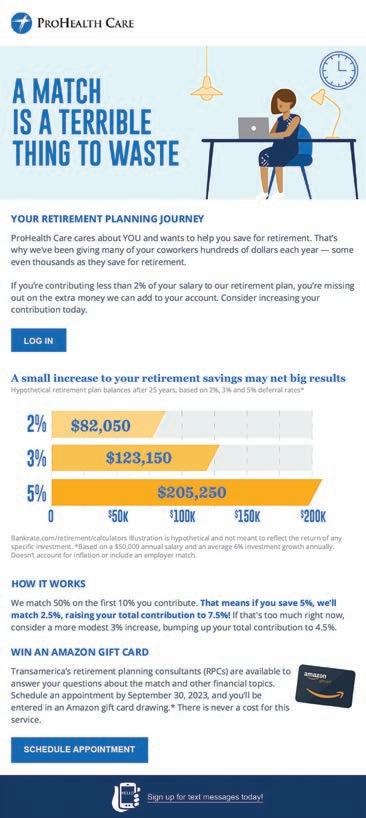
now available to all participants. Prior to the consolidation, the company’s bigger plan had 13 core investment options with no target-date funds.
When it converted its plans, Westinghouse Electric had a total of $1.7 billion in assets.
In addition to consolidating their plans, Colorado State University and Westinghouse Electric had to communicate the change to their participants.
While plan sponsors may nd the scale of these projects daunting, when the opportunity to convert or consolidate presents itself, it’s good to “take the leap,” Pribozie said. After all, they will “ultimately nd very cooperative partners and record keepers that will support” them, he added.
A helping hand: Southeastern Freight Lines (top left) and ADP TotalSource (top center), both winners for pre-retirement preparation campaigns, asked employees many of them over 50 to take a close look their retirement readiness. Westinghouse (top right) trumpeted new options in the company’s newly consolidated retirement plan. Special projects winner San Joaquin County (far left) used an interactive, 3-D courtyard to disseminate retirement information, while ProHealth Care (near left), another special projects winner, sought to lessen the information overload new hires experienced while going through the rm’s onboarding process.
While planning for retirement is important, it might not be fun and alluring for plan participants.
But for municipal employees in San Joaquin County (Nationwide Retirement Solutions), they turned out to engage and immerse themselves in retirement planning through an interactive, virtual experience.
The Stockton, Calif.-based municipality wanted its employees to be better acquainted with the resources and nancial tools offered by Nationwide Retirement Solutions, its new service provider. The two teamed up to create a colorful, 3-D courtyard — complete with a garden and smoothie shack — where users could click on buttons to access education videos, a quiz and information on how to schedule one-on-one meetings with a retirement specialist.
Through a link or QR code, employees could visit the space at any time from their computer or phone, and from the of ce or from home. Each visitor of the courtyard — which saw 61% engagement among all 5,060 county employees — engaged with at least six of the 10 available activities.
Nationwide “pulled out all the stops” when it came to the quality, giving participants a change from “the type of communication they
tend to see from the county government,” said Jennifer Goodman, director of human resources for the municipality.
San Joaquin and Nationwide jointly won rst place among public plans with between 1,000 to 5,000 participants in the special projects category. The municipality’s retirement plan had $543 million in assets as of Dec. 31.
Other winners in the category turned to targeted communication campaigns to get employees engaged. In the case of ProHealth Care (Transamerica), it paid close attention to its new, Generation Z-aged employees.
As part of a multiyear approach for increasing its minimum savings rate from 2%, the Waukesha, Wis.-based company wanted to encourage the 30% of its 5,700 employees who were contributing at most 2% to increase their deferral rate.
This rate “is not quite enough to create a comfortable and stress-free retirement,” said Stephanie Barenz, compensation and bene ts analyst at ProHealth.
After 30 days of work, new employees are automatically enrolled into the retirement plan. But Barenz noted that given that they may experience an “information overload” while going through the onboarding process, they may not realize they’re in the plan or be aware of the tools and resources provided to them to prepare for retirement.
For Gen-Z employees in particular, she said they might be going into ProHealth with little nancial literacy knowledge, so this could also be their rst time participating in a 401(k) plan.
To make sure its employees know they’re in the plan and realize that the 2% rate is not enough for a secure retirement, ProHealth sent monthly emails with different subject lines, graphics and informational videos. As a result, the company saw nearly 500 people increase their deferral rate, with 298 exceeding 7% — 165 of them maintaining an average rate of 11%.
The company — which operates medical facilities such as urgent care centers — had over $616 million in assets in its retirement plan as of March 22.
Additionally, ProHealth saw a 67% spike in the number of individuals who actively participated in group meetings with a retirement planning consultant at Transamerica.
From this campaign, Barenz said “employees really do have a hunger for learning this,” adding that “just because this is a group of people that maybe is not as engaged, (that) doesn’t mean that they don’t have questions.”
ProHealth (Transamerica) — which won second place among corporate plans with more than 5,000 employees — gave participants who met with a retirement planning consultant the chance to win an Amazon.com gift card. It was one of several entries in the category that used incentives to promote participation.
Northern Arizona Healthcare (Transamerica) turned its 401(k) plan into a safe harbor plan, increased its contribution rate upon auto-enrollment to 5% from 4% and increased its employer match to 100% on the rst 5% of eligible pay. The hospital system, which won rst place among not-for-pro t/other plans with between 1,000 and 5,000 participants, communicated these changes to participants through a custom website and an email campaign.
The platform provided information and resources, notably highlighting the ability to schedule one-on-one appointments with a retirement planning consultant at Transamerica. Those who met with the consultant could earn 500 points in its employee wellness program. After employees reach a certain number of points, Northern Arizona will invest in their health savings account and lower the premium for participants in a high-deductible plan.
“If you give somebody a present and you don’t tell them that you gave it to them, then they’re not going to know that they can go open it,” said Mary Porter, human resources information services and bene ts administrator at the hospital system.
P&I reporters were on the ground in Orlando, Fla., March 10-12, for P&I’s annual DC East conference, which brought together top plan sponsors and industry experts. What follows is a roundup of key panels.
A key to encouraging millennials and GenZers to save more for retirement is for nancial experts to ask them what they want rather than tell them what they need, according to Anne Lester, a former head of retirement solutions for J.P. Morgan and author of “Your Best Financial Life.”
“Are you listening to people,” asked Lester, noting that younger investors process information differently than older investors. “We need to meet them where they are.”
Communication must be targeted to their needs, said Lester, adding that these younger employees have been targeted individually by advertisements from a young age.
GenZers and millennials have three major concerns about saving: they don’t think they can afford a house; they don’t think they will get much from Social Security; and they don’t trust institutions.
Don’t make young savers feel that they are stupid or lazy, she said. Instead, encourage them to establish an emergency savings fund.
“We can help them feel better about the progress they are making,” she said.
Robert SteyerRetirement expert J. Mark Iwry walked plan sponsors through several key provisions in SECURE 2.0, a comprehensive retirement security bill signed into law in December 2022.
Iwry, former senior adviser to the secretary of the Treasury and deputy assistant secretary for retirement and health policy and currently a visiting scholar at University of Pennsylvania’s Wharton School and non-resident senior fellow at the Brookings Institution, started off his discussion by highlighting one of the law’s most widely discussed provisions: one that requires catch-up contributions for DC participants to be Roth contributions if they earn $145,000 or more per year.
After industry pushback, the IRS in August announced a two-year transition period for sponsors to implement the law, pushing back its effective date to early 2026.
Currently, participants who are 50 and older can have their catch-up provisions subject to the traditional plan funded with pretax money or the Roth plan funded with after-tax money depending on a sponsor’s rules.
As part of its August announcement, the IRS said the Treasury Department and the IRS “plan to issue future guidance to help taxpayers.” They asked for public comments about the Roth catch-up provision that were due in October.
Iwry said plan sponsors need to hear additional answers from Treasury by the early fall in order to have enough time to effectively implement the provision.
“I’m betting that they will meet that target because they get it,” Iwry said. “The last thing they want to do is give another deferral.”
On SECURE 2.0’s “saver’s credit,” Iwry said the provision will provide certain workers with a better incentive to save for retirement and give plan sponsors more assets to oversee.
Under the provision, beginning in 2027, low- and middle-income workers who contribute to a workplace retirement savings plan or individual retirement account will be
eligible for a 50% match on up to $2,000 they put into their accounts, courtesy of the federal government.
For individuals making less than $20,500, that translates into $1,000 if they manage to set aside $2,000. For couples earning less than $41,000, the match can go as high as $2,000 if they put $4,000 in. The matches will be deposited directly into their retirement accounts.
“It doesn’t have any relation to the employer match and the government will put it into your plan if you and your record keeper agree,” Iwry explained. “You can decline to take these; I hope you won’t.”
Brian CroceIn early 2023, International Paper added a stand-alone private real estate fund to two 401(k) plans, which is a mixture of 75% private real estate and 25% real estate investment trusts.
The goal was to make sure the fund provided daily valuation and liquidity, said Diana K. Winalski, deputy CIO at International Paper, noting that the company interviewed several asset managers and took about a year to develop and launch the fund.
Her company is using the Prudential Retirement Real Estate Fund, a separate account that invests in commercial real estate properties and real estate investment trusts.
The company chose this approach because it determined a strictly REIT fund was too correlated with a small-cap equity fund. The company also didn’t want to add to the DC plans the private real estate funds in the company’s pension plan because they didn’t offer daily liquidity or daily valuations.
To guard against overinvesting, the company capped at 25% how much the fund could represent in a participant’s account balance, and the plan makes clear to participants about potential risks, she said.
The real estate fund also is offered as part of the plans’ managed account service, which accounts for $5 million of the $7 million currently invested in the real estate fund.
The two International Paper 401(k) plans – one for hourly employees and one for salaried employees – have combined assets of $6.3 billion covering 48,000 participants.
It’s crucial for retirement plan duciaries to maintain records and have prudent policies and procedures in place to ensure regulatory compliance and have a better chance of successfully handling a Department of Labor audit or fee litigation lawsuit, according to experts on a plan oversight panel.
Keeping a documented paper trail on plan operations and decision-making should be a major focus for all plans, said Michael Kreps, principal and chair of Groom Law Group’s retirement services practice
“It’s all well and good to have the best processes in the world and you can have the most prudent process on earth, but if you haven’t written it down, you haven’t documented it properly, if you can’t prove that that happened, then it effectively didn’t happen for all intents and purposes on an audit,” Kreps said.
Tammy Mahaffey, manager of retirement plans at Darden Restaurants Inc., which has $1.4 billion in de ned contribution plan assets with 35,000 participants total, said her company was audited by the Labor Department recently.
“We make sure that we have a very documented process relative not only to our administration — compliance testing, reporting,
5500 audits — but also to meet with our committees on a quarterly basis and we document absolutely everything,” Mahaffey said.
She later added, “The only reason we were able to be successful with those audits is we were very organized.”
Brian CrocePlan sponsors need to take a “wide-angle view” of the retirement income options they can offer in their retirement plans, rather than focus exclusively on guaranteed income products, said Matthew Tufano, retirement income product manager at Vanguard Group, Tufano urged plan sponsors to consider plan design features and “look at everything they have in the plan,” such as the exibility of systematic withdrawals and their investment lineups, which can play an important role in helping participants with their retirement income needs, he said.
Vikrant Arya, managing director of the retirement investment group at TIAA/Nuveen, noted that plan sponsors need to be realistic about participant utilization of annuities, noting that “100% utilization” is not realistic.
The objective of offering guaranteed income is to “provide options for people who need it most, while making sure not to disadvantage people who may not end up selecting income at the end of their journey,” he said.
Nick Nefouse, managing director, global head of retirement solutions, multiasset strategies and solutions at BlackRock, pointed out that plan sponsors need to determine whether they’re offering a retirement plan or a savings plan.
Not all plan sponsors are interested in taking care of participants in retirement and therefore are looking only to build a savings plan for their employees, he said.
For those that do want to offer a retirement plan, they need not offer options that are 100% guaranteed income, meaning options that annuitize the full balance of participant retirement accounts.
The amounts annuitized can be “as low as 15%, maybe 30%,” Nefouse said.
Margarida CorreiaJaimie Erickson is director of retirement plans, Corporate Human Resources at Abbott, a pioneer in providing student loan matching pre-SECURE 2.0 legislation.
She says the bene t has signi cantly increased engagement with workers since the popular Freedom 2 Save student loan matching program launched in 2018.
At a panel discussion on “Implementing SECURE 2.0 Provisions” on March 11, Erickson offered retirement plan sponsors interested in doing something similar a guide she called Blueprint.
But energy company AVANGRID is not a fan of the student loan matching provision, and instead opts to implement direct loan assistance to employees.
Paul Visconti, senior director, Total Health and Retirement Programs, at AVANGRID, said that student loan matching is too administratively complex to track.
The company instead contributes $250 month to the retirement accounts of eligible non-union employees who are paying back student loans.
Visconti estimates that employees have saved $1.5 million in interest and principal since February 2023.
Margarida CorreiaReal estate debt is both a boon and a curse, with higher-for-longer interest rates offering the potential for respectable returns as well as signi cant issues for existing investments.
The good news is there is a sizable investment opportunity offering rescue nancing for borrowers needing to re nance their debt. While banks are beginning to once again lend to private equity-backed companies, they want nothing to do with real estate debt, which is wreaking havoc on their balance sheets. This puts private real estate debt managers in a fortunate position to capture that business.
“It’s a really good time to be a nonbank lender,” said Eric Adler, president and CEO of PGIM Private Alternatives, which has $310.9 billion in assets under management. “Banks are making a comeback in private equity in general but not in real estate.”
The bad news is that real estate managers are sitting on portfolios with real estate loans coming due that will need to be re nanced at higher rates than originally anticipated, which could cut a big hole into returns. And the same interest rates that could offer higher returns than private lenders have seen in years are also increasing the cost of capital
and making real estate valuations uncertain. As a result, transactions have stalled.
Until real estate transactions restart, there’s not a lot of volume for real estate private lenders, Adler said.
The bulk of the new loans have been in a few sectors including well-performing multifamily and student housing, Adler said. These are sectors in which there is not a lot of opportunity because there has been a consistent ow of capital into those spaces, he said.
There is a lot less capital available for real estate development, one of the riskiest types of loans, but unlike in the past few years, lenders willing to take on the risk will get paid for it, Adler said.
Real estate transactions are not expected to restart in earnest for quite some time.
“We are in the midst of a broad repricing of the entire real estate asset class as a result of a con uence of events that have happened over the last couple of years,” said Christy Fields, managing principal, real estate at Meketa Investment Group, at the March 6 meeting of the Oregon Investment Council, which oversees the $97.7 billion Oregon Public Employees Retirement System, Tigard. Meketa is the pen-
sion fund’s general investment consultant.
These events include “deeply dislocated capital markets for commercial real estate largely caused by a rapid rise in interest rates,” she said.
“We have negative leverage for the rst time in many people’s careers,” Fields said. “If you can get leverage at all today, the cost of debt capital exceeds going-in yields (future income compared to the purchase price) and so there’s an immediate drag on your portfolio.”
What’s more, the real estate industry is suffering from slowing rent growth, with of ce “the poster child” of this event, she said.
Everything industry executives “knew about analyzing real estate in 2019 is in the garbage because of these factors,” Fields said.
This has resulted in a dearth of transactions because owners don’t want to take the discounts that buyers are requiring, she said. The lack of transactions results in little market data, making it dif cult for appraisers to assess real estate values.
“Noncore real estate managers are trying to raise capital and hunt for debt opportunities”, Fields said. “It’s not really a virtuous cycle. Frankly, it’s the opposite.”
However, there are signs of loosening up. There have been a handful of distressed sales by distressed owners of real estate, she said. Banks

OPPORTUNITIES
BECKON: According to PGIM Private Alternatives’ Eric Adler, investing in real estate development loans, while risky, could provide a nice payoff.
are just starting to sell some of the loans on their books, potentially freeing up capital to make new loans and prices at or near the bottom, she said.
“We probably need another quarter or two, hopefully not three, to see that in ection point,” Fields said. “The sentiment in the market right now is survive until 2025,” she said.
While Oregon of cials are keeping a sharp eye on the pension fund’s existing real estate debt, they are considering increasing the fund’s exposure to the real estate credit sector, said Gloria Gil, senior investment of cer for real estate at the same meeting. The pension fund has $13.2 billion in real estate.
Their plan is to take advantage of the dislocation in the market by in-
vesting in private real estate debt, Gil said. Oregon’s staff is researching the potential of providing bridgenancing to save troubled projects. Oregon of cials are considering investing in structured debt, selling the senior part of the debt to another lender and retaining the mezzanine, which could provide double-digit returns, she said.
“It’s very attractive right now and it’s short-term” with a two- to threeyear window of opportunity, Gil said.
Real estate debt is still a small sector of the asset class. Debt funds account for 16% of private real estate fundraising and 14% of infrastructure fundraising over the past four years, according to Preqin. So far this year, as of March 14, three funds closed on $1.7 billion, compared to
Private equity has been more reactive to market conditions for the past couple of years and if that trend keeps up, sources say it may start to impact pacing models for investors.
Private equity prides itself on being uncorrelated to macroeconomic trends, but those have been almost impossible for the asset class to avoid. In 2021, following the pandemic, private equity had a record year — merger and acquisition activity was high, fundraising went well and returns were solid. But rising in ation coupled with an abrupt increase in interest rates in 2022 and 2023 have caused a slowdown in M&A activity, drops in valuations and subsequently, distributions back to investors.
Pacing models are typically designed to withstand short-term trends, but plans released by institutional investors for 2024 show that some investors are making tactical changes to provide exibility in this new environment.
“Investors are getting fewer distributions
than they planned for and at the same time they are also getting fewer capital calls,” explained Junying Shen, vice president and cohead of the private assets research programs in the institutional advisory and solutions group at PGIM. “Slower cash ow in general can create planning issues for investors that have a pacing strategy and want to invest in new vintages.”
There is a risk, Shen said, for investors if they aren’t getting the distributions back that they anticipated that they might miss new vintages and often the funds that come to market immediately after a slowdown can be some of the best performers.
This was a lesson many investors learned in 2009, when they pulled back from the asset class in the aftermath of the global nancial crisis only to watch as funds from 2010 and 2011 outperformed signi cantly, Shen said.
“Investors see that there is a transition happening within the economy right now and they want to be invested in that through their GPs,” Shen said. “But there are cash constraints
within institutional portfolios that can limit what they are able to do.”
Luke Riela, principal and macro research and data analytics coordinator at Meketa Investment Group, agrees. He said clients are watching the dynamics around valuations, interest rates and M&A closely but also noted that there is a measure of cyclicality to private equity distributions — some years are higher than others and that reality should be included in a pacing model that is meant to look at the medium- to long-term ( ve to 10 years) expected opportunity set within the asset class.
“There is a sense that some of the market dynamics we’re seeing play out are a bit transitory,” Riela said. “The speed with which interest rates increased contributed to a well-publicized decline in realizations for private equity managers, but we are seeing some evidence that the impact of that could start to recede over the next couple of years. We are always cautious of focusing too much on the short term or trying to time the market because that can lead to suboptimal outcomes in a portfolio.”
Holding on while private equity funds ac-
climate to the new market environment seems to be how some investors are responding to ongoing denominator effect issues in their portfolios.
Consultants say that in the short term, investors have been able to shift cash from more liquid asset classes to cover more immediate needs, noting that denominator effect problems can take as long as a few years to work themselves out.
The $41.1 billion Iowa Public Employees’ Retirement System, Des Moines, for example, is overweight private equity but within acceptable ranges, according to a presentation included with Dec. 7 board meeting materials. At the end of 2023, allocations to private equity, private credit and private real assets sat at 19.1%, 5.6% and 8%, respectively; their respective targets are 17%, 8% and 9.5%.
Still, the pension fund plans to commit up to $700 million each to private equity and private credit and up to $500 million to private real assets during 2024, spokeswoman Shawna Lode said.
The $13 billion Sacramento County (Calif.) Employees’ Retirement System is holding the same posture. According to its annual investment plan report for 2024, the pension fund’s private equity portfolio has a target allocation
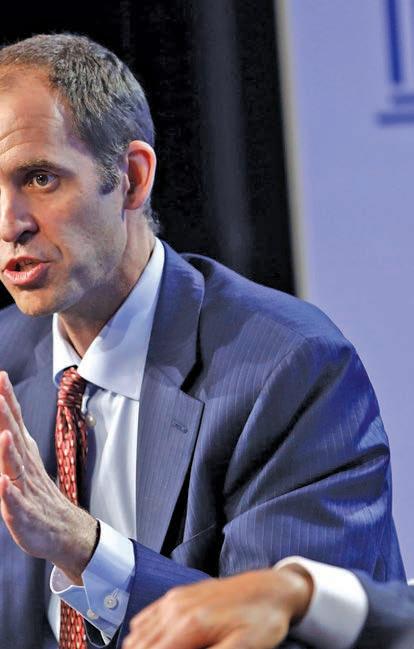
$24 billion raised by 59 funds in all of 2023. That compares to 210 real estate debt funds in the market in 2023, seeking a total of $61.3 billion, Preqin data shows.
Indecision by borrowers
The biggest challenge in the market now is that borrowers can’t decide what their investment strategies should be, said Bryan McDonnell, managing director, head of its U.S. debt business and chair of global debt for PGIM Real Estate.
Borrowers are seeking much shorter loan durations because the future is uncertain, McDonnell said. In the past, real estate debt could last up to 15 years. These days, a borrower that might have sought a 10-year loan is asking for ve years, he said.
“And there is a lot more capital than is advertised,” he said.
Commercial mortgage-backed security loan lenders are being very aggressive, offering very borrower-friendly terms. The spread between what an investor could earn from real estate compared to a bond is coming in quite a bit, meaning that there isn’t much difference between real estate yields and the risk-free rate of a U.S. Treasury bond, McDonnell said. Banks are picking their spots and starting this year, bank executives are guring out how to get their real estate debt problem behind them, he said.
“I’m more optimistic” because PGIM executives are nding some interesting deals especially in transitional lending, which is an area banks have shunned, McDonnell said.
But PGIM makes these investments “in a way where we can properly underwrite the risk,” he added.
PGIM is not alone.
“Real estate equity investors engage in a never-ending search for the lowest cost capital,” said Brian Carr, co-founder and managing partner of HighBrook Investors, a real estate manager with about $5 billion in assets under management.
“As deposit-funded banking institutions and insurance companies have experienced overexposure and looming defaults in their own balance sheets, private real estate lenders have moved in to take up the slack of traditional lenders,” particularly regional and smaller U.S. banks, Carr said.
“Certainly, as of yet, this hasn’t precipitated a widespread banking crisis,” he said. “That said, it has created a window for the private real estate lenders to provide higher-cost loans on their terms.”
That’s the potential investment opportunity that lies ahead. There is also the legacy real estate debt, loans

of 11% with a $200-$300 million commitment target for 2024 — consistent with 2023. As of Sept. 30, the allocation stood at 13.3%.
“While the private equity allocation is overweight to the 11% target allocation, it has come
issued three or more years ago when interest rates were low that had optimistic property performance assumptions that did not re ect the scenario investors are faced with today, said Chris Hentemann, managing partner and chief investment of cer at real estate management rm, 400 Capital Management, which has $6.2 billion in assets under management.
“I think legacy is evolving as we speak…it’s a slow-moving train wreck,” Hentemann said.
400 Capital trades securities, including commercial mortgage-backed securities, in a hedge fund-like structure and originates debt for longer-hold investment strategies.
“Rating agencies (of CMBS) are behind in adjusting ratings to the reality of real estate performance, and I think ratings are lagging,” Hentemann said.
“The real risk is not re ected in the ratings,” giving investment-grade ratings to securities whose assets have below-investment-grade risks, he said.
Hentemann sees the legacy loans as a potential opportunity set. Executives at 400 Capital are interested in good properties with bad nancing where the current note holder just can’t hold the property any longer, he said.
“We can buy the loans at deep discounts and restructure the loans,” Hentemann said. “There are tens of billions of loans that will struggle to re nance.”
Kingbird Investment Management also sees investment opportunity in the millions of mortgages that will need to be re nanced in a much higher interest rate environment than originally anticipated.
“We believe there will be a meaningful amount of preferred equity opportunities” for the next 18 months, said Lei Farrand, managing director of capital markets and investor relations at Kingbird. n
down signi cantly from the 15.4% allocation in last year’s report, as the lag effect of private equity valuation declines has caught up with the public market valuation declines in 2022. SCERS also sold some small allocations to a few legacy secondary fund of funds from the 2006-2008 period, which reduced the private equity allocation on the margin. Given private equity’s unique cash ow characteristics, it is important that SCERS commit to private equity funds across vintage years to maintain its target allocation to the asset class,” the report said.
Other investors have made moves to increase their private equity targets.
According to a Jan. 11 board meeting presentation, the $325.9 billion California State Teachers’ Retirement System, West Sacramento, has been steadily increasing its investments in private equity, taking the portfolio from 8% to 14%, and expects improved distributions from its investments despite the slowdown within the asset class.
“We may be at an in ection point for the program … where net cash ow from the program is starting to turn positive,” said John Haggerty, managing principal director of private investments for Meketa Investment Group, the pension fund’s consultant, during a video broadcast of the meeting.
On March 19, the $492.8 billion California Public Employees’ Retirement System, Sacra-
Regulators and legislators are looking closely at private equity investments in key industries.
At the state and federal level, lawmakers are concerned about rapid price increases and consolidation in the healthcare industry as a result of private equity investment. Federal legislators are also looking into private equity and venture capital support of companies in technology sub-sectors including semiconductors and arti cial intelligence. They argue that investments in tech companies in adversarial nations like China are undermining U.S. competitiveness and national security.
These combined efforts could limit where private equity funds can invest and could raise duciary concerns for institutional investors with exposure to these funds, sources said.
Healthcare a focus
In February, California Assemblymember Jim Wood introduced a draft bill that targets private equity and hedge fund investment, ownership and management of healthcare facilities in the state. The bill would give the attorney general more pow-
mento, announced an increase in its allocations to private equity and private credit. Speci cally, the system will add 4 percentage points to private equity, bringing the target to 17%.
Dan Bienvenue, interim chief investment of cer, had said at the time that if the committee didn’t adopt the new asset allocation, another downturn could force the pension fund to be over its outside target range. CalPERS’ private equity allocation has a target range of plus or minus 5%, and the new 17% target gives the pension fund the ability to have a maximum of 22% without being over its maximum allocation.
Ashley Kahn, senior vice president and analyst manager in the alternatives consulting group at Callan, said these kinds of tactical moves like adding a little more exibility to target allocations can allow investors to position themselves well to deal with short-term issues while still maintaining a long-term view of the asset class, but added that there are still things to watch out for.
Private equity fund managers have turned to solutions like net asset value lending and continuation funds to manage liquidity during the slowdown. Investors involved in those transactions may need to adjust their pacing models more immediately than those investing in new commingled funds, Kahn said.
“Continuation funds have a different type of drawdown structure,” she said. “You’re invested right away if you choose to go into a
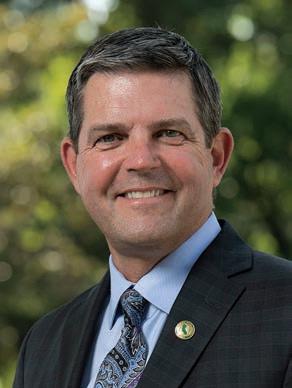
MORE CONTROL: California Assemblymember Jim Wood’s draft bill targets private equity and hedge fund involvement in healthcare facilities.
er over change of control transactions involving private equity and hedge funds and healthcare facilities or provider groups. Wood isn’t alone. Lawmakers in other states, including Illinois, Pennsylvania, New York, Rhode Island and Oregon are seeking to monitor and potentially limit rapid consoli-
continuation fund, so that will push up your allocation quite quickly.”
Kahn doesn’t include continuation funds in her scenario analyses because they tend to be one-off transactions, but if they continue to grow that could change. “I wouldn’t be surprised given where the trend is going for GPled secondaries that it may become something we need to think about including in the future, she said.
Cutting back
At the same time, some plans have indicated that they are reducing targets within their private equity portfolios, speci cally to venture capital.
At its March 13 board meeting, the $76 billion Los Angeles County Employees Retirement Association, Pasadena, Calif., voted to lower its target range to venture capital to 5%25% of the private equity portfolio from 15%30% previously. LACERA said the changes were designed to “re ect current market dynamics” within venture capital and to provide “ exibility.”
The $20.2 billion Los Angeles Water & Power Employees’ Retirement Plan is making a similar move in venture capital. Plan ofcials plan to underweight venture capital and funds of funds and increase commitments to late-stage and growth capital funds, “which can be made directly and at scale,” according to a March report from StepStone, the pension fund’s private equity consultant. n
dation and price increases within healthcare.
Rep. Ben Bowman in Oregon brought up a similar bill during the state’s most recent short session. House Bill 4130 would prevent private equity rms from controlling medical practices and dictating patient treatment or making hiring decisions. The bill was successfully stalled by Republicans using the short session to limit voting, but Bowman said he plans to bring the bill back in the next session.
“I rmly believe that providers should be in control of clinical deci-
sion-making,” Bowman said in an interview. “I am strongly opposed to the idea that it is acceptable for private equity and large corporations, who have an obligation to their shareholders and not their patients, to be in charge. Medical decisions should stay between patients and their providers.”
There are multiple federal investigations underway as well.
In December 2023, the chair and ranking member of the U.S. Senate Budget Committee Sens. Chuck Grassley, R-Iowa, and Sheldon Whitehouse, D-R.I., launched an information gathering effort that is ongoing to understand the impact of private equity on healthcare.
The White House also announced in December that it was taking ac-
tion to promote competition in healthcare, including greater scrutiny of acquisitions and “a cross-government public inquiry into corporate greed in health care.”
Following up on that announcement, the Department of Justice, Federal Trade Commission, Department of Health and Human Services and Centers for Medicaid and Medicare Services announced a joint investigation earlier this year into private equity practices across healthcare.
Policymakers cite recent research in the Journal of the American Medical Association showing a signicant negative impact on patient outcomes when private equity is involved in healthcare. According to the report, private equity acquisition
of hospitals was associated with a 25.4% increase in hospital-acquired conditions.
Private equity has invested over $1 trillion in the healthcare industry over the past decade, according to data from the Commonwealth Fund.
A recent study from the American Antitrust Institute shows that in 13% of metropolitan areas, a single private equity rm owns more than half of the physician market for certain specialties.
If these efforts are successful, sources said specialized healthcare private equity funds could nd themselves with a diminished opportunity set and note that investors may want to look closely at the regulatory risks of current exposures.
Critical technologies
Federal policymakers are also seeking to limit venture capital and private equity activity in what the government considers to be critical technologies such as semiconductors, arti cial intelligence and surveillance. Some of those efforts have already come to pass.
Provisions in the Creating Helpful Incentives to Produce Semiconductors Act (or CHIPS Act) seek to cut off American dollars from funding primarily foreign companies that are deemed adversarial to U.S. interests. A Commerce Department rulemaking formalized last year put guardrails around chips that are critical to U.S. national security needs, including current-generation and mature-node chips used for quantum computing, in radiation-intensive environments and for other specialized military capabilities.
The House Select Committee on the Chinese Communist Party wants to take it even further. The committee adopted 150 policy recommendations at the end of last year and released a report highlighting how venture capital and private equity investments in some Chinese companies working on critical technologies are creating national security concerns. Some Chinese companies have already been blacklisted in the United States.
In an interview, a congressional aide said the committee’s goal was additional legislation that would limit the ow of American money into Chinese companies working on critical technologies similar to those outlined in the Commerce Department’s rulemaking.
“Critical and emerging technologies that pose a particularly acute threat to national security should be the focus of legislation and a focus of outbound investment prohibitions,” the aide said.
The committee’s policy recommendations report gets speci c about who might be the target of those prohibitions.
“Congress should also enact legislation that requires private equity rms, as well as employee retirement plans governed by the Employee Retirement Income Security Act (ERISA), to disclose their continuing investments in companies based in or controlled by foreign adversaries,” the report said.

Multifamily and warehouses, which have fared the best of most property types thus far through a gale storm worth of headwinds in the commercial real estate asset class, could be in for a rocky trip.
Industry insiders expect returns for both sectors to fall this year as a result of oversupply and slowing rent increases. Apartments are predicted to be among the lowest returning of the four main property types in 2024 at -1.7%, with industrial expected to produce a 0.7% return in 2024, according to the latest Pension Real Estate Association Consensus Forecast survey.
Of ce is the lowest with a -6.3% expected return in 2024 and retail is expected to be the highest returning sector at 2.9%, the survey results show.
Overall, it’s not a great time for real estate. Real estate investment trusts fell 30% from their peak at year-end 2021 to their trough in October 2023 but rebounded at the end of the year, now standing more than 20% above their October 2023 lows (as of March 2024). Private real estate is down nearly 20% since the third quarter of 2022 and is expected to drop another 5 to 10 percentage points in 2024 and into next year, a Cohen & Steers report shows.
Some investors are focusing on investing in distressed real estate caused by the rise in interest rates.
One of the implications of the higher-for-longer interest rate environment we are in is that “real estate is a real train wreck,” said Stephen Sexauer, chief investment of cer at the $17 billion San Diego County Employees Retirement Association, at the board’s Feb. 15 meeting. SDCERA is investing in “ re sales of good properties.”
Real estate investors should expect more real estate devaluation due to high borrowing costs, said Gloria Gil, senior investment of cer for real estate at the March 6 meeting of the Oregon Investment Council, which oversees the $97.7 billion Oregon Public Employees Retirement System, Tigard. The pension fund has $13.2 billion in real estate.
She noted that OIC of cials expect oversupply in multifamily and industrial due to new construction in the two most-favored property types. This should make 2024 and 2025 good
vintage years to acquire real estate assets.
“I have been waiting for this correction,” Gil added.
In this environment, of ce, which has been decimated by the work-from-home shift, multifamily and industrial properties are expected to suffer the most, the Cohen & Steers report said.
There’s been a strong secular case for the apartment sector since the global nancial crisis when millennials were in their 20s and moving out of their parents’ basements into apartments, said James Corl, executive vice president and head of the private real estate group at real assets manager Cohen & Steers. But now those same people are starting families, moving to suburbs and buying homes, causing the investment case to fall apart, he said. It doesn’t help matters that during the last economic cycle, investors overpaid for multifamily and invested in new multifamily development projects, which are now causing a glut of apartments in certain areas, Corl said.
Warehouses face headwinds
Warehouses were the darling of property types as consumers adopted online shopping over going to the mall, especially during the pandemic, Corl said.
Internet shopping caused the “retail apocalypse” as well as a tremendous boom in warehouses, he said.
“Everyone loves warehouses” but that property type's investment case is too falling apart, he said. Industrial properties are suffering from very rich valuations and a boom in construction, which is causing occupancy of warehouses to fall and other fundamentals at the margins to deteriorate, Corl said.
Another reason is the “counterattack of the traditional store-based retailers,” he said. Apparel businesses are moving from malls to strip centers and the largest retailers like Walmart and Target have turned themselves into last-mile distribution centers, Corl said.
“Warehouses are overpriced and underperforming,” he said. “This has not been internalized by the real estate community overall.”
Close to 80% of Blackstone Real Estate Income Trust — Blackstone’s $114 billion nontraded REIT — is invested in multifamily and industrial properties, according to information

on BREIT’s website.
“The real estate world is very weighted to multifamily and industrial property types and those property types are really going to struggle,” Corl said.
Brian Carr, co-founder and managing partner of real estate manager HighBrook Investors, said that multifamily is more likely to have “pockets of distress” than the industrial sector.
“Particularly in what we describe as growth-cycle markets, which while they generally grow faster than the rest of the country, are now experiencing slowing or declining rents when factoring in incentives given by landlords to tenants as well as supply issues.
Industrial properties, while also acquired at high prices, are in better shape because rents have continued to grow, “though at a less blistering pace than in previous years,” Carr said.
Multifamily in Europe, especially continental Europe, is expected to have a brighter outlook than in North America, said Sandrine Amsili, managing director, real estate debt at Ardian.
“There is a strong need for additional residential surfaces, especially in metropolitan areas such as Paris, Berlin or Milan,” Amsili said.
Besides development, reconstruction or transformation of obsolete of ces into residential spaces will offer numerous opportunities, he said
But in the U.S., new construction of multifamily properties could keep some pressure on rents from rising, said Rajesh Agarwal, a senior managing director and portfolio manager of U.S. mortgages and consumer strate-
gies at Napier Park Global Capital, which has $20 billion in assets under management.
Matt Jones, a managing director and chief investment of cer of credit strategies at Harbor Group International, which specializes in multifamily credit, said that the apartment sector has had a change of fortunes, impacting debt managers as well.
“The era of double-digit rent growth is over,” Jones said. “Rent growth has basically gone to zero right now.”
At the same time, operating expenses in multifamily are growing as are costs for utilities and staf ng and labor costs, Jones said.
“Properties that are underperforming will not be bailed out by a good market,” he said. For that reason, Harbor Group is focusing on the safest loans at the top of the capital stack, Jones said.
There were a lot of opportunities 18 to 24 months ago when multifamily borrowers were renovating properties with a plan to get rental premiums, he said.
Those investment plans have proven to be very dif cult to execute right now, Jones said.
Right now, private credit investors need to build in a margin of discount and be willing to work through issues arising at the properties, Jones said.
While defaults as well as loan modi cations and extensions are starting to tick up, he said that some real estate values are not accurately re ecting the risk. The prices Harbor executives are seeing debt trade on these properties are “not accurately re ecting the magnitude of workouts that may be coming,” Jones said.
Deal values plunged 37% and exit values dropped 44%, mostly due to interest rates; better days seen for 2024
By PALASH GHOSHWithin global private equity, deal value plunged by 37% to $438 billion in 2023 from $699 billion in the prior year, while exit value dropped by 44% to $345 billion from $613 billion over that time period.
In addition, 38% fewer buyout funds closed — declining to 449 in 2023 from 722 in 2022, according to Bain & Co.’s “Global Private Equity Report 2024” issued March 11.
Indeed, since reaching their peaks in 2021, deal value and deal count have fallen 60% and 35%, respectively, while exit value has plummeted 66%, and the number of fund closings has dropped almost 55% since 2021.
These declines in activity have had a “chilling effect” on fundraising, the report said, citing that slower distributions have left limited partners “cash ow negative, crimping their ability to plow more capital back into private equity.” The private equity industry raised $1.2 tril-
lion in fresh capital in 2023 (down 20% from the $1.5 trillion in 2022), while the buyout category attracted $448 billion, the report stated.
Moreover, LPs were “highly selective,” Bain noted, citing that “while capital owed to the largest ‘reliable hand’ buyout funds, fundraising for most was as hard as it’s ever been.”
“The word for this market is stalled,” said Hugh MacArthur, chairman of Bain’s global private equity practice, in the report. “The culprit was the sharp and rapid increase in central bank rates, which caused general partners to hit the pause button.”
For now, exit channels have largely evaporated, leaving GPs with a massive $3.2 trillion in unsold assets and restricting the ow of capital back to LPs.
However, MacArthur is optimistic about 2024. “Interest rates appear to have stabilized” he noted in the report. “Record dry powder is stacked and ready for deployment. Nearly half of all global buyout companies have been held
‘Record dry powder is stacked and ready for deployment. . . . Conditions appear to be shifting in favor of hitting the ‘go’ button .’BAIN & CO.’S HUGH M ac ARTHUR
for at least four years.”
In short, MacArthur added, the “conditions appear to be shifting in favor of hitting the ‘go’ button,” while the report observed that “green shoots of a recovery are starting to poke through,” with the likelihood of moderating interest rates as the most important driver of a potential recovery.
Even slight cuts in interest rates are likely to stimulate deal-making “as long as the macro outlook remains relatively stable,” Bain said in the report. Moreover, buyout funds alone are currently sitting on a record $1.2 trillion in dry powder, with 26% of that gure 4 years old or older, up from 22% in 2022.
“That creates a heavier incentive than nor-
mal for GPs to get off the sidelines and start buying, even if conditions aren’t ideal,” the report noted. “Activity is already ticking upward, and with help from the Fed (Federal Reserve) and the European Central Bank, the bias in 2024 is likely to the upside when it comes to deal count and value.”
Exits also pose some problems, the report said. “Barring a sharper-than-anticipated drop in rates, sellers will continue to face high hurdles to unloading companies to strategic buyers, other sponsors, or the public markets,” Bain said. “With sponsors struggling to send cash back to their LPs, 2024 will likely be dened by how creative the industry can be in nding ways to generate liquidity.”
The portfolio companies that will excel in this “dif cult market” are those that have used every means possible to boost earnings before interest, taxes, depreciation and amortization “ef ciently and can demonstrate to the next owner that there’s money left on the table,” Bain said. This will require funds to “get sharper at nding and pulling the value-creation levers that generate organic growth — pricing, sales-force effectiveness, and product innovation,” among others.
































CONTINUED FROM PAGE 3
the partial withdrawal of a third, BlackRock, pose a setback to global engagement on climate change,” said Jens Munch Holst, CEO at AkademikerPension, Gentofte, Denmark, in emailed comments.
“Recognizing that climate transition aligns with the nancial well-being of our pension fund members, AkademikerPension believes that engaging with companies on climate risks is crucial to ful lling our duciary duty. Urgency is paramount and we need the world’s largest emitters to take necessary action on climate change — the escalating risks of neglecting climate concerns pose even greater risks,” he said. AkademikerPension has about $20 billion in assets.
There’s also an expectation from clients that their money managers honor their wishes. A spokesperson for APG, which runs more than €500 billion ($546.9 billion) in assets, said it “strongly believe(s) in the power of collaborative engagement to address systemic risks like climate change and will continue to participate in relevant initiatives, also on behalf of our pension fund clients. We expect our external managers to contribute to the climate objectives our clients have set.”
Kirsten Snow Spalding, vice president-investor network at Ceres, a sustainability-focused nonpro t and founding member of CA100+, agreed that client expectations are key. While climate action wasn’t a part of a manager presentation in the past, asset owners are now saying “show me what you’re doing, how you are managing that risk. I expect those signals to continue, and participation in Climate Action 100+ is a signal — of the work managers are doing, that they’re using the best data, aligning with peers, and learning,” she said. “We expect to see those signals continuing from the clients, and where the managers are not responding I would expect to see changes over time,” Spalding added.
Reaffirming commitments
A number of institutional investors restated their own commitment to CA100+, including Sweden’s AP1, Stockholm, with 454.4 billion Swedish kronor ($45 billion) and the 426 billion kronor AP2, Gothenberg. A spokesperson for Stockholm-
CONTINUED FROM PAGE 2
However, at the Feb. 1 board meeting, the board of directors had already voted to eliminate the 2% target allocation to emerging markets equities and lower the target to international equities to 7% from 14% based on the recommendation of Borden, the CEO/CIO.
“Our target weights that we’re proposing to you (the board) increase our expected rate of return from 6.6% to 7.05%, almost half a percent of returns annualized, but here is the secret sauce of diversication,” said Borden at the Feb. 1 meeting. “We’re also eliminating certain very risky allocations in emerging markets debt and emerging markets equity, and we’re able in this case to experience a rate of return that’s almost half a percent higher at
based AP4, with 499.6 billion kronor, said in an email that “the issue is complex. AP4 continues to support the CA100+ initiative and it is our belief that we as long-term investors need to be active owners and in uence our portfolio companies to be part of the transition.”
Local government pension scheme pool Border to Coast Pensions Partnership, Leeds, England, sees climate risk as a key investment risk, said Jane Firth, head of responsible investment. “As a global, longterm investor committed to reaching net zero by 2050 or sooner we believe it is critical that we appropriately manage this risk across our portfolios on behalf of our LGPS partner funds.”
Border to Coast further strengthened its policies on responsible investment this year. “As part of this we have restated our commitment to the aims of the Climate Action 100+ and embedded its net-zero benchmark into our voting policy. We can achieve far greater progress on net zero by using the power of our collective voice, and we are proud to support the aims and ambitions of Climate Action 100+,” Firth added. Border to Coast invests on behalf of 11 local authority pension funds that have a total about £60 billion ($77.1 billion) in assets. The pool was responsible for £40.3 billion in assets as of March 31, 2023.
The continued divergence in sentiment over ESG has also not gone unnoticed by pension funds. Pensions and insurance rm Folksam, Stockholm, is “concerned about the anti-ESG movement in various parts of the world,” a spokesperson said in an email.
Folksam is a founding member of the Net-Zero Asset Owner Alliance, and is “convinced that climate risk is nancial risk.” Folksam engages with portfolio companies “not only because we, as an insurance and pension provider serving half of the Swedish population, want to be a contributing force in the climate transition — we are doing it because we believe it reduces risk and ultimately will have a long-term, positive effect on the return we deliver to our clients.”
ESG has been fully integrated into the investment process for two decades. “We will continue to encourage and support all our portfolio companies on their decarbonization pathways,” the spokesperson said. Folksam had group assets of 527 billion Swedish kronor as of Dec. 31, 2022.
actually lower risk.”
In a March 20 email, Borden said “Navarro 1 was eliminated as a direct result of the elimination of an allocation to EME. The other BlackRock strategy was a world ex-U.S. strategy that both included EME exposure, as well as having its overall target reduced.”
“The main implication of Texas Government Code Section 809 was the fact that we chose not to engage BlackRock in a new revised international equity strategy at this time, and therefore are closing the existing strategy altogether,” said Borden. “This certainly brings the PSF into closer alignment with the spirit and intent of Section 809.”
Borden also noted in the email that the law and its guidance “is nuanced in its application with respect to direct ownership of listed rms vs other contractural relationships, in order to allow for sound duciary judgement in the speci c actions
CA100+ launched in December 2017. Originally a ve-year initiative, it last year announced its Phase 2 strategy, which runs from 2023 to 2030 and aims to “inspire a global scale-up in active ownership, markedly shifting the focus from corporate climate-related disclosure to the implementation of climate transition plans.”
Careful reviews
Companies will be asked not just to disclose, but to “implement robust transition plans and to take action with a wider set of stakeholders to address the sectoral barriers to the net-zero transition,” an update said.
Phase 2 “is not a change in the priorities or direction or the tactics,” Spalding said. “What is, I think, clear is as many of the companies on the focus list have made net-zero commitment, the focus is now on how are they implementing those commitments. It’s an accountability commitment ... (companies) can only address risk by changing behaviors.”
So why did these managers depart or shift their relationships? It comes down to that Phase 2 change, some told P&I
quarter of 2020, “at a time when CA100+ was focused on corporate disclosure.”
The new phase “will require signatories to make an overarching commitment to use client assets to pursue emissions reductions in investee companies through stewardship engagement. In our judgment, making this new commitment across our assets under management would raise legal considerations, particularly in the U.S.,” the BlackRock note said.
Some U.S. state attorneys general, governors and lawmakers have alleged that climate-related alliances
are economic factors so, where material, will continue to be considered.
Diverging paths
Others said that their participation in the initiative was no longer aligned with their own approaches to sustainability.
PIMCO regularly reviews external initiatives, “and we have concluded that our Climate Action 100+ participation is no longer aligned with PIMCO’s approach to sustainability,” a statement said. “PIMCO operates its own portfolio-relevant engagement activities with issuers on sustainability.”

SSGA concluded after “careful review … that the enhanced Climate Action 100+ Phase 2 requirements for signatories are not consistent with our independent approach to proxy voting and portfolio company engagement,” a spokesperson said.
The rm believes that managing climate-related risks and opportunities is a key part of nding long-term value for clients. “Our asset stewardship team anchors its program on effective board oversight and disclosure of material risks and opportunities, including those that are climate-related. This has been, and will continue to be, a core aspect of our stewardship program and was never predicated on membership in any organization. Our commitment to climate-related efforts has not changed, and we will continue to enhance our research capabilities, partnerships, and data analytics to build climate investing solutions for our clients,” the spokesperson added.
The Phase 2 requirements were also a reason for membership transfer to BlackRock International, according to a note to media. The manager became a signatory in the rst

represent collusion among money managers, thereby violating antitrust laws.
The majority of BlackRock’s clients seeking climate, transition and decarbonization-related investment solutions are in the international businesses.
Further, the majority of strategies with decarbonization as one of the investment objectives — as well as those that are eligible to be run with the rm’s new decarbonization stewardship capability, which will give clients the option of prioritizing “the effective disclosure, oversight and execution of companies’ long-term strategies for a transition to a low-carbon economy” — are run by BlackRock International, the note said.
For those clients that have not told BlackRock to prioritize decarbonization as an investment objective, the rm will continue to vote and engage “with a sole focus on advancing their long-term economic interests,” the note said, adding that climate risk and the transition
‘How our clients invest and whom they entrust to manage their money is entirely their decision, but we feel an action of this magnitude warrants transparency and consensus — not political-driven decision-making.’
BLACKROCK’S MARK M c COMBE
taken regarding broader tangential relationships with listed rms.”
The school fund is in the process of reallocating those assets, which is not yet complete.
BlackRock fires back
“Your actions put short-term politics over your long-term duciary responsibilities,” Mark McCombe, a
BlackRock vice chairman, said in a letter March 21 to Kinsey. “We were dismayed.”
McCombe urged Kinsey and the board to reconsider, arguing that BlackRock has worked with the Texas Permanent School Fund for almost two decades and has produced strong investment performance with competitive fees. The rm’s interna-
And Invesco said it withdrew after careful consideration, “as we believe our clients’ interests in this area are better served through our existing investor-led and client-centric issuer engagement approach.”
JPMAM said its own efforts to beef up stewardship and engagement activities were behind its departure. A spokesperson con rmed it was not renewing its membership “in recognition of the signi cant investment it has made in its investment stewardship team and engagement capabilities, as well as the development of its own climate risk engagement framework over the past couple of years.”
The rm has 40 dedicated sustainable investing professionals, who leverage research from more than 300 analysts globally.
“We believe that climate change continues to present material economic risks and opportunities to our clients, and our analysts will continue to factor this into engagement with companies around the world,” the spokesperson added.
Ceres’ Spalding said the four investors “are still members in the Ceres Investor Network, actively participating in our work and using our resources and tools.”
“There’s no sense they’re withdrawing from the important work around climate change. We do expect to continue working with these asset managers on their management of climate risk across their portfolios.”
Spalding added: “We were sad to see these four go, and we recognize that they are facing internal and external pressures, but we hope they will continue to do the work, remain aligned with the initiative whether they are signatories or not.” n
tional investing mandate beat the fund’s own benchmark during that span, generating more than $250 million for Texas, according to the letter.
“Ending a long, successful partnership that has been a positive force for thousands of Texas schools and families in such a reckless manner is irresponsible,” McCombe wrote. “How our clients invest and whom they entrust to manage their money is entirely their decision, but we feel an action of this magnitude warrants transparency and consensus — not political-driven decision-making.”
The Texas divestment is one of the biggest actions taken against BlackRock in the three-year anti-ESG campaign run by Republicans across the U.S. One of the few comparable moves was in late 2022, when Florida said it would pull $2 billion from the New York-based company. n
IFM’s growth strategy, broadening and diversifying our business by focusing sharply on the evolving needs of our clients. She hasn’t wasted a second since starting,” he said. She’s a “strong and experienced leader, with a reputation both as a fabulous thinker and as someone people love working with and for. She’s quickly built a really talented and driven team,” Neal added.
IFM had 68% of its AUM from Australian clients as of Dec. 31, 2022, according to Pensions & Investments data, and 15.5% from U.S. clients. As of Dec. 31, 2023, assets under management were A$216.8 billion ($147.5 billion), comprised of
A$108.8 billion in infrastructure, A$56.1 billion in debt investments, A$50.9 billion in listed equities and A$1 billion in private equity.
Just the list of names that have been announced publicly into senior and leadership roles — she’s actually added almost 30 staffers to the rm — reads like a Rolodex of who’s who in asset management and investment consulting.
‘When you attract the talent of this caliber, what you have to do is essentially create the environment where they glue together and they’re given an opportunity to thrive … ensuring they can be diverse, removing roadblocks on the way and letting them build .’
IFM
First up for Nikulina was John Gee-Grant as head of global client solutions, known for his previous roles in sales, business strategy and client relations at PGIM and BlackRock. Gee-Grant, who joined in May, has since been building his own team with heavy hitters, including Armit Bhambra as head of client solutions EMEA and Peter Swarbreck as head of client solutions Asia. Bhambra joined from BlackRock, where he was head of the U.K. corporate pensions business and prior to that built the rm’s asset owner business for iShares in the U.K., and Swarbreck was head of Asia-Paci c for Jupiter Asset Management and, prior to that, held senior roles at BlackRock.
INVESTORS’ LUBA NIKULINANext for Nikulina was Maria Nazarova-Doyle, who joined as IFM Investors’ rst head of sustainable investment in September from Scottish Widows, where she was head of responsible investments and stewardship. Prior to that, she held senior roles including as head of DC investments at JLT Employee Bene ts, and as principal and market engagement
leader in Mercer’s de ned contribution and individual wealth business.
“I had followed IFM for a long time and had been impressed by their commitment to sustainable investment practices as well as their distinct heritage of being owned by pension funds and inspired by pension fund members,” Nazarova-Doyle said in emailed comments. “When you combine all this with their track record of delivering for clients, I was really excited to be getting the opportunity to join the team and work alongside such great purpose-led colleagues,” she said.
Rounding out the hires for Nikulina’s senior leadership team was Rekha Misra, former global chief operating of cer at Willis Towers Watson, who took on the new role of global head of product strategy and innovation in December.








Misra’s addition to oversee product strategy and innovation is aimed at moving clients and the organization “to better see around the corners and understand where the market opportunity is going,” Nikulina said. With infrastructure capabilities and the general market environment so “fast-paced (and) quickly changing … we need to build up to quickly identify opportunities.”







Nikulina’s team is essentially responsible for all functions that relate to the external environment, such as “John’s team, which is dealing with clients taking care of existing relationships, but also helping develop new relationships … in new markets or new client types, outside the pension industry and into insurance, endowments and foundations, and private wealth.”
Her leadership team is also working on relationships with governments — a “very signi cant part of the value proposition,” she said. That’s because relationships with governments are important for infrastructure investing — for example, in November, IFM signed a memorandum of understanding with the U.K. government’s Department for Business and Trade, announcing the manager’s intention to invest £10 billion ($12.9 billion) in the U.K. by 2027.
The objective of the MoU is to drive IFM’s investment in the U.K. across large-scale infrastructure and energy transition projects, working with the government to identify investment opportunities. The agreement also re ects IFM and Australian super funds’ appetite to invest in the U.K., a news release said, adding that, with the size of the Australian retirement system set to grow to about £4.7 trillion by 2040 (from £1.8 trillion now), more capital will need to be deployed in aligned economies.
And Nazarova-Doyle and her team are adding to a rm that already had sustainability at its heart, Nikulina said. The power of the collective seen in the 1980s Australian trade union movement to create a compulsory retirement system served as inspiration for super funds to come together and collaborate on institutional investment — and thus IFM was born in the mid-90s.
“Everything related to social considerations of investment has always been incredibly important,” Nikulina said. The rm had already made a net-zero commitment by 2050, with a 2030 interim emissions reduction target of 40% vs. 2019 levels for the infrastructure portfolio.
But “in this space, you have to run very fast to stay in the same place,
and even faster to be able to move forward,” she said, paraphrasing Lewis Carroll’s Red Queen character in “Through the Looking-Glass.”
“Maria is a real game changer for what we could do in terms of just better de ning — I’d call it right-sizing — what we do. There is so much that is needed in this area, that the challenge becomes not so much the opportunity, but rather the ability to execute on all those opportunities that we face,” Nikulina said.
With a number of different coalitions and partnerships available, “even with the buildup of resources, we still only have limited resources — so we need to be sure we direct our energy into the right causes where we can cause the biggest positive impact,” such as the energy transition.
Nazarova-Doyle — whom Nikulina described as a “powerhouse” — has also just hired a senior person in New York, “which was critical to get this sustainability angle, what’s happening in the local context, and be able to deliver our message there in a way that’s properly understood.”
The sustainability team is also “doing a lot on lifting the level of skill and awareness in the rm,” Nikulina said. While sustainability has always been a focus, it’s “such a fast-changing environment, one needs to keep upskilling themselves.”
Investment sweet spot
There’s also fortuitous timing right now for infrastructure investment — IFM’s sweet spot — with a tailwind of government calls for private capital to ow into projects.
The need to renew existing infrastructure is “genuinely mission-critical for society,” with a need for utilities, ports, airports and other infrastructure to be part of the transition to a low-carbon future, Nikulina said.
Alternative energy sources, renewable infrastructure and new technologies are also on Nikulina’s radar from a strategy point of view. Those technologies, she said, may not yet be fully commercial or developed from a scienti c perspective, “but have the potential to change our society. And (that is) all overlaid by sustainability considerations.”
Nikulina has found the rm’s focus on infrastructure, coupled with IFM’s ownership structure, “as a magnet, telling this story to people who I have been recruiting. I knew it attracted me (to IFM,) but it was positive con rmation (since) we were able to attract such talent.”
As a leader, “when you attract the talent of this caliber, what you have to do is essentially create the environment where they glue together and they’re given an opportunity to thrive … ensuring they can be diverse, removing roadblocks on the way and letting them build,” Nikulina said.
And Nikulina is already familiar with the concept of super teams — coined by executives at her former employer and its Thinking Ahead Institute. The TAI describes super teams as “combining diverse and exceptional talent … (whose) collective intelligence is fully leveraged by great culture and governance. This collaborative culture may require staff to gain new skills, or have dormant skills put to work,” the TAI said in a white paper on culture.
“This organization is already making a lot of positive difference for the world, for society. It’s a genuine privilege to be here and help turbocharge it,” Nikulina added. n
CONTINUED FROM PAGE 1
risk and return of the whole portfolio.”
The four institutional asset owners and co-authors of the paper — Australian sovereign wealth fund Future Fund, Melbourne; Canada’s largest pension fund, Canada Pension Plan, Toronto; sovereign wealth fund New Zealand Superannuation Fund, Auckland; and GIC — all consider governance, a healthy partnership with and structure among the board of directors, the starting point of TPA, Bowman noted.
In the CAIA report, Jayne Bok, head of investments-Asia at Willis Towers Watson, stressed that TPA is not a speci c model with a singular destination. Rather, it comprises a range of approaches that can be tailored to each asset owner in order to design a portfolio that best represents the team’s long-term investment thesis.
To further delineate some of the differences between total portfolio approach and strategic asset allocation, while SAA seeks to outperform benchmarks, TPA focuses on the fund’s absolute-return goals. While SAA seeks diversi cation via asset classes, TPA wants diversi cation through control of various risk factors. And while in SAA-centric organizations, portfolio decisions tend to be implemented by multiple teams competing for capital, in a TPA house, there is just one team collaborating together on decision-making.
And crucially, while the board dominates the portfolio construction under the SAA model, the chief investment of cer is much more empowered in a TPA approach.
Bowman said that in a 2019 global study of 18 asset owners that use forms of TPA, the Thinking Ahead Institute argued that the advantages of this new approach are more than just cultural and theoretical — participating funds felt that the approach yields 50-100 basis points of outperformance over traditional SAA methods.
Charles Hyde, head of asset allocation at the NZ$64.5 billion ($39.7 billion) New Zealand Superannuation Fund, cited that perhaps the best indicator of the power of TPA to increase returns is the recent Global SWF report of sovereign wealth fund and public pension fund returns over the past 10 years, which showed that three of the top ve funds were adherents to the TPA — New Zealand Super, CPP and Future Fund.
CAIA’s own research on 10-year performance of their asset owner co-authors also yielded 140 basis points of annual outperformance against the NACUBO endowment composite during the same period. That said, the paper warns that tremendous changes in management, cultural transition and leadership alignment is necessary to migrate to a TPA mindset and therefore may not be right for many organizations, he said.
Australia’s Future Fund
Ben Samild, CIO of Australia’s A$272.3 billion ($180.1 billion) Future Fund, said in an interview that while TPA means different things to different investors, “to us it means that every investment and divestment decision is carried out with reference to the needs of the total portfolio and not any subportfolio
objective or benchmark.”
The Future Fund has embraced TPA since its inception in 2006.
Ultimately, he noted, this approach to better decision-making guards against overdiversifying at the asset class level and underdiversifying at the portfolio level. Narrow asset class objectives and incentives tended to lead to suboptimal outcomes at the portfolio level, he explained.
TPA has led to good returns and a reduction in risk, Samild said. “Our asset allocation changes daily based on opportunities and sometimes quite signi cantly based on a changed assessment of the investment environment,” he added.
Samild also said that TPA does not necessarily require an expanded investment team. To the contrary, he observed, “as teams get larger and strong interpersonal relationships
made, this can lead to overinvestment in some asset classes and underinvestment in others,” Hyde stated. “It can also lead to overdiversi cation within asset classes.“
The main bene t of using TPA is that it enables an investor to be more exible in responding to change in the investment environment. “It enables an investor to ensure that the marginal dollar invested is in the most attractive asset available regardless of asset class,” he added.
“That is, it solves the problem of overinvestment in certain asset classes that arises when an asset class team with a xed budget to spend has a dearth of attractive opportunities.”
In addition, TPA doesn’t favor the inclusion of any particular asset classes in the portfolio.
But since TPA by design requires a more collaborative approach to in-

TPA ‘enables an investor to ensure that the marginal dollar invested is in the most attractive asset available regardless of asset class.’
NZ SUPER’S CHARLES HYDE
are more challenging, the approach becomes more dif cult to scale and one needs to be extremely thoughtful about process and culture.”
New Zealand Super
NZ Super’s Hyde said in an interview that TPA is an “umbrella term used to describe approaches that break down siloed thinking within a fund by creating a culture and investment framework that results in all investment decisions being viewed through a whole-of-portfolio lens.”
NZ Super adopted TPA in 2010. “The rationale for the change was the recognition that it made sense for our board to focus on governance and for most investment decisions to be delegated to management as this is where the investment knowledge and skill largely resides,” he explained. “This provided the investment team with the exibility and freedom to be truly opportunistic investors.”
Moving toward a total portfolio approach requires a reassessment of team structures, benchmarking practices, compensation incentives and development of a collaborative culture. In contrast, the traditional approach involves allocating a xed amount of capital to each asset class team and leaving it up to each team to decide how to allocate that capital.
“Because the return environment may not resemble what was anticipated when the allocations were
time,” he said. “TPA just allows us to be more exible so that we ensure we are investing in the most attractive assets at a point in time.”
However, he observed that TPA has changed the way the investment team functions in many ways but it has not led to an expanded staff. “In fact, having a smaller team is benecial to the extent that TPA requires more communication and collaboration and this typically becomes harder in larger teams in which people are less connected,” he said.
“One change is that we have introduced a role which has the purpose of connecting our portfolio managers with the top-down view so that they are more total portfolio aware. Another is that we have abandoned the traditional asset class team structure — our teams are organized along functional lines with each spanning all asset classes. We have also developed a suite of total portfolio reports that allow everyone to see how each investment — both prospective and existing — compare with each other across all the relevant dimensions — including risk-adjusted return, liquidity usage and resource intensity. This provides the foundation for an informed discussion in real time about the merits of any given investment.”
CPP, GIC
Derek Walker, managing director, head of portfolio design and construction-total fund management at CPP Investments, said in an interview that TPA differs from a traditional portfolio in which capital is allocated to each asset class, and in turn each asset class team operates independently and is focused on running their silo of capital within the portfolio.
CPP had C$590.8 billion ($445.7 billion) in assets as of Dec. 31.
vesting, this can present challenges since it requires more communication and coordination across the investment team.
But Hyde cautions that it’s hard to say de nitively whether TPA has increased the fund’s returns since the counterfactual is unknowable. “As for risk, we target a level of risk in our portfolio and expect to earn returns commensurate with this level of risk,” he said. “TPA doesn’t change this risk target. We have con dence that this is the right approach because of its strong underlying logic.”
Hyde further indicated that “a lot of funds” have approached his fund seeking guidance as they contemplated moving to a total portfolio approach.
“Some have made the transition, others are still working on it,” he said. “It is a large undertaking to re-engineer an investment framework, team structure and culture and doing so could require buy-in from of a range of stakeholders. So, while I expect over time more asset owners will make the switch, it’s certainly conceivable that it won’t become the dominant approach any time soon. The most powerful catalyst for change will be if adherents of TPA continue to outperform non-adherents.”
TPA hasn’t affected NZ Super’s asset allocations in any systematic way, he noted. “We still allocate risk budget in proportion to our assessment of expected attractiveness over
The key bene t of TPA is that it “allows us to better understand and quantify” the return-risk characteristics of each asset class, and how those asset classes in turn relate to underlying return-risk drivers, or factors, when we construct diversied portfolios. “By focusing on the underlying drivers rather than the asset class labels, this approach is also more exible than a traditional SAA and enables us to take advantage of market conditions and our expertise when and where opportunities arise,” Walker added.
CPP rst implemented TPA in 2006. “The goal was to improve risk-adjusted returns for the portfolio to ensure the Canada Pension Plan Fund is strong and nancially sustainable for the long term,” he explained.
Chiam of GIC said in the CAIA report that when TPA is done well, it allows an investor to design a diversi ed portfolio that is aligned with investment objectives and balanced across competing trade-offs. The key to its success, he added, hinges upon “an organizational culture built on long-termism and agility, with all employees sharing one clear focus — to deliver good, real returns for the total portfolio over the long term.”
GIC has an estimated $770 billion in assets.
Chiam emphasized that funds using TPA must embrace a long-term focus.
“This means that we are focused on fundamental value, rather than short-term changes in price, which are often in uenced by market sentiments at each point in time,” he said. “This enables us to navigate short-term uncertainty, capitalize on market dislocations, and compound returns over time.” n


Wednesday, April 3 | 2:00 pm ET
Governance, implementation, specialist manager access, market complexity, lack of expertise or bandwidth: a host of reasons are behind the diversity in types of institutions and the growth in scale of capital pools that are engaging OCIOs, or outsourced chief investment o cers. With allocators focused on alpha-generating sources of return as they look ahead to the next decade — particularly via alternatives and private markets — OCIOs are bringing their discretionary expertise and specialized relationships with asset managers to the forefront. Many OCIOs are delivering flexible and custom mandates, tailored to specific allocator segments and even specific institutions’ needs within each segment, which is further encouraging industry growth. OCIO performance measurement, value-added services and education, and innovative methods of accessing asset managers are all top of mind for asset owners as they partner with OCIOs today. Our panel of OCIO experts shares the latest in types of mandates, current priorities for di erent allocator types, and the greater e ciencies being delivered through new data and technology that, while significant, will not replace the more nuanced collaborative relationship.
REGISTER | pionline.com/ocio-webinar24
Sponsored by
Wednesday, April 17 | 2:00 pm ET
Institutional allocators in fixed income are always scanning the horizon for signals on macroeconomic shifts and the next central bank moves. Even in the midst of the very positive resurgence of fixed income, they need to carefully navigate this transition period for interest rates and inflation so they can remain on track to achieve their long-term objectives. It’s an opportune time to reach for quality with reasonable risk exposure across several segments of fixed income, and stretch out on the credit spectrum into high-yield, emerging markets, and other sectors.
Our panel of fixed-income experts cuts through the market complexities to share what’s top of mind for the di erent types of institutional clients today. You’ll also hear what’s current in fixedincome indexing and the use of actively-managed ETFs, new developments in systematic indexing, and opportunistic segments –including private credit.
REGISTER | pionline.com/fixed-income-webinar24
Sponsored by

Available on demand
Conducting business on mobile devices – e.g., phones and laptops – is a necessity in our industry. However, compliance and security gaps continue to surface, despite compliance policies and data safekeeping measures. These gaps are creating regulatory and reputational risks, some with hefty associated price tags. For example, the SEC is now targeting investment companies for “ochannel” communications. Similar e orts with institutional brokerdealers resulted in nearly $3 billion in fines in less than two years. Meanwhile, access and data through mobile devices remain a favorite breach point of cybercriminals targeting investor data. Recent events show that even pension funds are not immune to attacks.
REPLAY | pionline.com/TMBmobilecompliance-webinar24
Sponsored by

CONTINUED FROM PAGE 1
BlackRock’s world-beating $10 trillion in assets under management, said he doesn’t pretend to have all the answers. But BlackRock’s work as an investment rm for 35 million Americans preparing for retirement “has given us some insight into how a national initiative to modernize retirement might begin.”
Over the coming months, “BlackRock will be announcing a series of partnerships and initiatives” aimed at launching a broad discussion on retirement security, he said. Further details will be forthcoming at a later date, a BlackRock spokeswoman said.
In April, meanwhile, BlackRock will debut LifePath Paycheck, a new target-date fund with an annuity option, courtesy of insurance partners, to address “a frustrating irony: As a society, we focus a tremendous amount of energy on helping people live longer lives” but put no effort into helping them afford those extra years, Fink noted. Life-extending obesity drugs that came out last year, including Ozempic and Wegovy, have brought that tension into stark relief, with the potential blessing of longer, healthier lives but added challenges in not outliving one’s savings, Fink noted.
The sponsors of 14 retirement plans, including the Tennessee Valley Authority and Advanced Auto Parts Inc., with combined target-date assets of $27 billion, will make LifePath Paycheck available to their 500,000 employees when the strategy goes live in coming months, Fink said.
fectively: ‘You’re on your own.’ And before my generation fully disappears from positions of corporate and political leadership, we have an obligation to change that,” Fink said.
Fink said efforts to x the U.S.’s retirement system should draw on other countries’ experiences, including the Netherlands, where the retirement age automatically adjusts with changes in life expectancy; In Japan, the government has made it easier for older cohorts who wish to continue working to do so. Australia — a “good model for American policymakers to study and build on” — makes employers contribute a portion of income for every worker between the ages of 18 and 70 into a retirement account belonging to the employee.
If BlackRock can help spark a national debate where people move beyond dug-in positions and compromise to nd workable solutions, that could prove a gratifying outcome for Fink, who became a target of political vitriol after taking a high prole stand in his annual letter for 2020
ambitious target, may be needed for the U.S. to grow itself out of its mounting government debt overhang, Fink said.
Energy security in focus
Fink conceded that since he began writing about the transition to a post-carbon energy world, “the issue has become more contentious in the U.S. ... but outside that debate, much is still the same.” People are still investing heavily in decarbonization, with an eye on energy security, he noted.
By way of example, last year a BlackRock infrastructure fund invested $550 million in a project called STRATOS, alongside Texas oil company Occidental Petroleum, to build the world’s largest direct air capture facility, capable of removing 500,000 tons of carbon dioxide from the atmosphere annually, Fink said.
“The energy market isn’t divided the way some people think, with a hard split between oil and gas producers on one side and new clean power and climate tech rms on the other,” Fink said. “Many companies, like Occidental, do both, which is a major reason BlackRock has never supported divesting from traditional energy rms,” he said.

The CEO cited a BlackRock survey showing that two decades after retiring, typical respondents, with enough money to live comfortably for the rest of their lives, still had 80% of their pre-retirement money on hand — a sign that “even people who know how to save for retirement still don’t know how to spend for it,” Fink said.
An annuity option, and the regular income it provides, can give retirees the con dence they need to spend down more of their nest eggs.
One study BlackRock participated in suggested the recurrent income provided by such annuity-linked strategies could allow retirees to boost their spending by almost 30%.
“I believe (LifePath Paycheck) will one day be the most used investment strategy in de ned contribution plans,” said Fink. “We’re talking about a revolution in retirement.”
That, in turn, should help address the uncertainties facing younger generations — millennials and Gen Z — in a de ned contribution-dominated retirement system where they’re tasked with ensuring the adequacy of their own retirement savings. Those young people are struggling to save, in contrast to the more paternalistic days of de ned bene t plans, he said.
Those younger generations “believe my generation — the Baby Boomers — have focused on their own nancial well-being to the detriment of who comes next,” noted Fink. “And in the case of retirement, they’re right,” he said.
“Today in America, the retirement message that the government and companies tell their workers is ef-
putting ESG factors at the center of BlackRock’s investment approach.
Despite highlighting BlackRock’s continued sizable investments in traditional fossil fuel companies and commitment to investing clients’ money in accordance with their preferences, the ESG backlash — with politicians in states with big fossil fuel interests compelling their public pension funds to withdraw mandates to BlackRock — has stretched into 2024.
On March 19, the $52.3 billion Texas Permanent School Fund, Austin, terminated BlackRock from roughly $8.5 billion in international and emerging markets equity mandates, in line with a state law forbidding public funds to work with managers seen as hostile to the fossil fuel industry.
In his latest annual letter, Fink noted that the situation on the ground in Texas — where a 28% chunk of the state’s energy consumption comes from alternative energy sources, 6 percentage points above the national average — and elsewhere, is marked by a greater degree of pragmatism than the country’s ongoing strident political debate suggests.
America’s efforts to cope with the trillions of dollars of government debt added over the past decade or more “have to center around progrowth policies, which include tapping the capital markets to build one of the best catalysts for growth: infrastructure,” and in particular, energy infrastructure, Fink said. Real GDP growth of 3% a year, an
While Fink says he remains an optimist — with optimism among the broader populace a key to individuals continuing to invest in capital markets as opposed to parking their savings under the mattress — he expressed considerable concern in his letter about the country’s current mood.
How to restore a sense of greater hope and optimism in the U.S. is “the rst question we have to ask, although I readily admit that I do not have the solution,” Fink said. “I look at the state of America — and the world — and I am as answerless as everyone else,” he wrote.
“There’s so much anger and division, and I often struggle to wrap my head around it,” he said.
Optimism, he noted, is what leads people to continue investing the market, as opposed to putting their money in the bank.
He pointed to a recent post-pandemic survey showing less than 50% of “young Americans” polled questioning whether life has a purpose and 4 in 10 saying it’s “hard to have hope for the world” as the most concerning data points he has seen over his 50 years in nance.
Still, there’s reason to be optimistic about the outlook for BlackRock’s business, Fink said.
“In 2023, our clients awarded us with $289 billion in net new assets during a period of rapid change and signi cant portfolio derisking,” contributing to a $1.4 trillion gain that lifted BlackRock AUM to $10 trillion, Fink said.
BlackRock’s strategy remains centered on growing its Aladdin risk management system business, “ETFs, and private markets, keeping alpha at the heart of BlackRock, leading in sustainable investing, and advising clients on their whole portfolio,” Fink said.
Over the rst few months of 2024, meanwhile, “we’ve seen a decidedly more positive sentiment and tone in markets and among clients that I’m very optimistic will carry into the rest of 2024,” Fink said.
CONTINUED FROM PAGE 3
though there is plenty of dollar liquidity in absolute terms, tightening is likely to negatively impact GDP for developed economies, which have become increasingly dependent on upping their money supply to fuel growth, McDonnell wrote.
“Our biggest concern with the money supply is the rapid depletion of excess savings,” he said, citing a Fed research report that found that most advanced economies will have largely depleted their accumulated excess savings from the COVID-19 pandemic. “This is quite important when considering that in 2023 the economic resilience was largely driven by very strong consumer spending,” he said.
With many corporations taking the opportunity afforded by excess spending to increase prices to grow pro ts, “any sort of weakness in the consumption impulse and it will have huge rami cations on business margins.”
Due to the downside risks, portfolios have been tilted away from cyclicals and into higher quality defensive assets, he said. Investment executives are “vigilant with our stock selection in our internal equity portfolios and try to invest in companies with clear competitive advantage that can weather a potential economic slowdown,” McDonnell said.
And the same applies across the xed-income portfolios, “where selectivity is key in this sector, particularly following the sharp rally in the last weeks of 2023.”
If consumer spending falls and re nancing becomes challenging for some issuers given tighter bank-lending standards, “vulnera-
CONTINUED FROM PAGE 6
year until reaching 10%, though the rate could also start higher than 6% — a maximum of 10% — and reach up to 15% the year thereafter. Employees could choose to opt out, and the bill directs the Treasury Department to create rules on the implementation of auto escalation.
For auto IRAs, employers could select the auto IRA provider or allow workers to choose their own, with a percentage of each paycheck contributing to their account based on preset rates. Starting at 6%, the rate would increase to 7% in the second year, 8% in the third, 9% in the fourth, and remain at 10% every year thereafter. Though the default would be a Roth IRA, employees could opt for a traditional IRA, adjust their contribution rate, or choose not to participate altogether, according to the bill summary.
“It’s admirable” that the bill starts participants at high contribution rates and includes automatic escalation, Magnolia said, adding, “I think those tools and mechanisms have worked well on the 401(k) side.”
The bill’s auto-enrollment provision is also a vital way to get individuals in a plan, Magnolia noted.
“Enrolling (people) right out of the gate takes one of the biggest obstacles off the table,” which is taking the initiative to join a retirement plan, he said.
The bill also directs the Treasury secretary to issue guidance allowing
bilities in lower-rate credit are likely to be exposed,” he said. Plus, the “dilution of covenant protections in recent years” means recovery rates are likely to fall should default rates rise.
“That said, we think that episodes of distress are more likely to be idiosyncratic rather than widespread as default rates could rise above longterm averages,” McDonnell added.
For xed income, McDonnell and the investment team continues to believe that long duration is the “most prudent allocation, given the current economic climate.”
The team likes government bonds, “as they are an obvious bene ciary of in ation peaking” and offer a degree of diversi cation, “which will be useful should equity markets begin to suffer. This also extends to emerging market debt, where proactive monetary policy over the past two years has been of net bene t to local economies,” McDonnell said.
As of March 31, 2023, assets under Border to Coast’s management were invested across equities (£20 billion,) xed income including multiasset credit (£8.3 billion), and private markets at £12 billion. Infrastructure carried the highest commitments at £4.3 billion, followed by private credit at £3.3 billion, private equity at £3 billion and climate opportunities at £1.4 billion.
Beyond the Magnificent Seven
Although equities made gains last year, much of the momentum came from the so-called Magni cent Seven stocks — Alphabet, Amazon, Apple, Meta, Microsoft, Nvidia and Tesla. These companies gained over 100% in 2023, vs. a 24% return for the overall S&P 500.
That concentration is something Border to Coast is aware of, and that it was “buoyed by the arti cial intel-
individuals outside of traditional employment to have access to auto IRAs, opening up the plans to freelance workers, independent contractors, gig workers and those who are self-employed.
Another provision in the bill creates a new tax credit for small businesses, which it de nes as under 100 employees, if such businesses facilitate auto IRAs, whether under national or state legislation. The credit allows for $500 per year for three years and applies to tax years starting after 2024.
Additionally, the bill requires 401(k)-type plans with over 100 participants to offer a lifetime income option under certain conditions. If the participant’s vested account balance is $200,000 or more, plans must offer them the option to receive at least 50% of that balance in the form of lifetime income, the bill states.
Some support, pushback
When Neal introduced the bill Feb. 7, several industry organizations voiced their support for the legislation.
“The American Retirement Association (ARA) strongly supports the Automatic IRA Act that will signicantly increase access to workplace retirement savings programs,” ARA CEO Brian Graff said in a Feb. 7 statement. “Importantly, it achieves this by leveraging the existing public-private partnership that drives the successful 401(k) system providing bene ts to over 100 million Americans.”
The Insured Retirement Institute, TIAA and American Council of Life
ligence boom that captured investors’ attention,” McDonnell said.
While the Magni cent Seven stocks have room to run, executives are also mindful of the expectations that are embedded in the current prices, and so are looking at AI carefully.
“Our overseas developed equity fund has bene ted from the explosion of the AI theme, particularly our overweight position to Nvidia,” he said. That fund had £6.2 billion in assets as of March 31. “We are cognizant of the fact that lofty expectations are embedded in the price and are somewhat concerned in the short term with a potential correction in the buildup of excess inventories among the cloud customers that account for more than half of data center sales. Given our short-term concerns, we are treading carefully and have taken the opportunity to crystalize some of the pro ts through our positioning,” McDonnell said.
ators in their respective elds.”
Looking to Asia
Executives are also looking to Asia for equity exposure, to China and Japan speci cally.
The Nikkei 225 gained 28% in 2023 — one of the top-performing markets last year, and the Bank of Japan grew more assertive in addressing weakness in the yen. With that in mind, Border to Coast executives prefer domestic companies with the potential to enhance shareholder value by improving governance and capital allocation, McDonnell said.
‘We are ... very careful to separate the (AI) hype from the opportunity and ensure that we invest our partner fund capital in the best quality operators in their respective fields.’
BORDER TO COAST’S JOE MCDONNELL
However, the AI theme is disruptive over the long term, and executives are already starting to look — carefully — at companies that may bene t from early adaptation to improve their operational ef ciencies. “Notwithstanding, this is a gradual process, and it will take time to evaluate the ability for companies to monetize on this opportunity. We are therefore very careful to separate the hype from the opportunity and ensure that we invest our partner fund capital in the best quality oper-
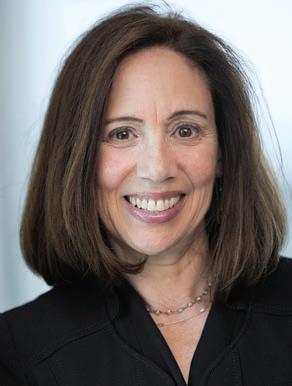
Insurers also spoke to the bene ts of the bill in letters and statements of their own.
More recently, a coalition of 21 organizations — including ACLI, ARA, Empower Retirement, IRI, Nationwide, Prudential, TIAA and Voya Financial — expressed their support for the legislation in a Feb. 27 letter to Neal.
“Your bill represents a meaningful step forward in strengthening and enhancing our nation’s retirement security,” the organizations wrote.
However, the bill may have a hard time getting through Congress, sources said, in part due to the bill’s “mandate.”
“To put in a mandate on small em-
increase rates and in effect help with the reshoring of capital from global corporate and nancial institutions,” he said.
Regarding China, McDonnell acknowledged that investor sentiment is at “extreme low levels as the property drags continue to affect consumers’ willingness to spend.”
But there are some positive signs that give executives some comfort that the worst may be over: “The piecemeal stimulus thus far has failed to ignite a signi cant rally but has managed to stamp out risks to the nancial stability,” he said. Chinese authorities have made a number of moves to stimulate the economy and stem out ows from stock markets.
The Tokyo Stock Exchange introduced the Corporate Governance Code in 2015, which was subsequently revised to include stricter requirements, he said.
“These efforts have accelerated this year as the Japan Exchange Group adopted a name-and-shame policy to push companies to improve shareholder value and improve communication with the market,” McDonnell said.
But improved governance is not the only reason why Border to Coast is bullish on Japan, with the macro environment also playing a key role since “Japan is essentially a net bene ciary of the in ationary pressures most developed markets have experienced. Following decades of stagnation, we are seeing the rst signs of sustained wage growth in Japan that would likely kindle more robust consumer demand. This will also help support the case for the BOJ to
ployers before you’ve really fully implemented and educated people on what’s out there, to me, seems very premature,” said Chantel Sheaks, vice president of retirement policy for the U.S. Chamber of Commerce.
Sheaks speci cally spoke to the research presented at a Chamber of Commerce event in late February.
That research included the 2023 Small Business Retirement Survey, conducted by the Center for Retirement Research at Boston College, which found that while 52% of small businesses cite cost as a major reason for not offering a retirement plan, most overestimate those costs.
Speci cally, 68% of small businesses believe that administering a plan would cost over $10,000 annually, though the average annual cost for a business with 10 employees is $2,500, or $5,000 for 50 employees, the research said.
Neal’s bill includes a tax credit for small businesses that facilitate auto IRA plans, which according to Vestwell’s Magnolia “levels the playing eld a little bit.”
In a previous interview with P&I, Neal said those tax credits “might enhance the prospects of getting this legislation advanced.”
However, Sheaks once again pointed to the research from the 2023 Small Business Retirement Survey. That survey found that only 24% of small businesses are aware of the tax credit that already exists for small businesses, which allows eligible employers with less than 100 workers to claim up to $5,000 for three years, according to the IRS.
“Furthermore, policymakers are clearly focused on supporting new growth drivers through innovation in areas such as digital economy, advanced manufacturing and green technologies. These are sectors that are very important to the global supply chain that are dif cult to replicate given China’s infrastructure and low-cost access to skilled labor,” McDonnell added.
That’s “also aligned with how external China managers are positioned as they are looking for companies with global dominant positions and ongoing commitment to innovation and technological advancement,” he said, citing the pool’s holding in solar company Sungrow as an example of this. The company has invested heavily in research and development, allowing it to offer advanced inverter products that are more ef cient and reliable than that of the competition, he said. “This clear advantage is the reason why we believe that Sungrow is a very important player to the global energy transition especially given our commitment to be climate-neutral by 2050,” McDonnell added. n
The existing tax credit is only applicable to employers who start a simpli ed employee pension plan, SIMPLE IRA, or other type of 401(k) plan, whereas the tax credit in Neal’s bill is speci cally targeted toward employers that facilitate auto IRAs, which do not require a company match.
“A tax credit is all well and good, but if you don’t know about it, it’s actually not all well and good,” Sheaks said, adding that the three-year limit on the credit is also restrictive.
“Right now, it is questionable” whether the bill can make it through Congress, according to Sheaks, since “a mandate is not necessarily something that everyone is going to support.”
“There’s strong feelings around the word mandate,” Magnolia said, but proposed that “maybe there’s a different way to characterize it” to get people on board.
SSGA’s Kahn noted there is bipartisan support for a different kind of bill, which would give workers without an employer-based retirement plan access to a federal program similar to the Thrift Savings Plan, though “that’s a requirement,” just as Neal’s bill is a requirement, she said.
Ultimately, “once we get some states that have Republican legislatures (and) Republican governors on board (with state auto IRA programs), I think we will be able to get Republicans more interested in this,” Kahn said.
When asked in a previous interview if he thought the bill could pass, Neal said, “I’m going to stay at it as I always do.” n


Frost, who joined the California Public Employees’ Retirement System as CEO in October 2016 and oversees a global investment portfolio of $492.8 billion, also discussed active vs. passive management, the need to support and empower female leaders, as well as the allure of sports teams as investments. Frost was named to P&I’s inaugural In uential Women in Institutional Investing list in 2023 and appeared in Barron’s 100 Most In uential Women in U.S. Finance in 2021.
Questions and answers have been edited for style, clarity and conciseness.
Q | I wanted to start off with the CIO search. We know you have a shortlist and CalPERS is about to make an announcement soon.
A | We’ve been pretty clear about the attributes that we’re looking for in the CIO seat: That is, someone who comes in with a very strong investing background and someone who can lead a pretty large team. Someone who has the resiliency really to work in a highly transparent public fund, and as we know, not everyone is in a place that they feel like they can do that. And some who believe they can, and they get into the seat, and they realize the rst time it happens, you know, this is really not what I want to do. But really testing and going through a lot of conversations about resiliency, and tell me times when these situations may have happened to you (and) how did you respond to those. How did you stay on track? How did you stay on message? How did you stay on performance? So the candidates have done very well in that area. And then, strong communication skills along with being a very public fund. CEM Benchmarking has us as the
into high-yield municipal bonds — for helping the rm offset continued headwinds for its equities business.
Those strategic moves — which saw First Eagle’s legacy large-cap value equity business decline to roughly 67% of total AUM from almost 95% over the past eight years — started before he arrived, with the 2011 liftout of a Dwight Asset Management high-yield bond team, the rm’s rst foray into xed income. But Mahmud has taken the baton and run with it.
“Our strategy is to focus on areas where there’s sustained customer demand, where active management, and therefore best-in-class talent, can add meaningful value, and where First Eagle’s client-centric culture can be a differentiator,” he said in an email.
No. 1 most transparent fund in the United States and along with that comes the need for high communication skills to be able to explain the decisions we’re making at CalPERS.
Q | CalPERS recently boosted its private equity allocation, and one of your shortlist candidates has that background. Did all of your CIO candidates agree with the private equity allocation that you folks just made?
A | CalPERS, you’ll remember, when Nicole Musicco rst came in and she and I worked on a presentation that I felt was extremely important to understand the impacts of when we are not pacing our capital into private equity — even at the asset target or the policy targets that we had. We were still struggling after the 2008-2009 nancial crisis, and as you know, those vintages performed very well and we didn’t have capital working for us.
There are a lot of lessons learned in 2008-2009, but we did this 10-year lookback at private equity as an asset class, and where we did well and where we needed to learn from some missteps that had happened. CalPERS, regardless of this current CIO search, CalPERS has been working to increase its private equity or alternatives exposure by hiring, you know, Anton Orlich (Orlich was named managing investment director for the CalPERS private equity group in November 2022). That was certainly one of the strategic moves that Nicole made, one of her rst hires, and he was a return to CalPERS but had done quite a nice private equity book at Kaiser, and so this is really more of a re ection of Anton and his team, their ability to restart the co-investment program.
Their ability to really negotiate structures that allow us to move from some of the concentrated rela-
Mahmud said market segments that meet all of those criteria include:
■ Alternative credit, his initial gambit with the 2017 acquisition of private credit boutique NewStar Financial.
■ Small-cap equities, with the liftout of a Royce Investment Partners investment team in late 2021.
■ And high-yield munis, with the hiring last year of former Nuveen veteran John Miller and the subsequent build out of his team.
The CEO said his team’s approach to expanding First Eagle’s product mix involves identifying markets promising structural growth and then identifying top investors in those segments and waiting for dislocations in the market to put those investors in play.
Insisting instead on one’s own timetable for establishing new capabilities runs into the hurdle of only
tionships that we had with the larger GPs, more into that mid-market, which opened up more venture, it opened up more diversifying the assets across managers, so not only are we seeing a better kind of risk-return, less fee drag, but also the importance that we place on manager diversity.
Q | Are you folks looking to move your exposure into active vs. passive management? Other pension funds are moving in that direction with the volatility in the markets.
A | We are. We’ve been predominantly passive for a number of years. Back in 2019, I believe that we did a complete active risk review. We took a lot of active risk out of the portfolio at that time, but the intention was always to add it back in when we have conviction about a manager in particular. Markets seem to do a good job of pricing at risk on the shorter term and maybe not as long-dated, two years and above.
I think that a bene t that we have at CalPERS is our capital is long term. We can focus there and nd like-minded managers who can align appropriately, and whether that’s climate, whether that’s where we see risks related to climate, we think some companies are doing better than others and then taking an active bet on that. We are bringing that into public equity. We just closed out the RFP for manager selection there. There is more active and xed income than we’ve ever had in the past, so you do see a slight shift away from being purely passive, outside of the private asset classes, more on the public side. That was a strategy also brought in by Ben Meng who canceled the active management, again, (but) always intended to bring it back in.
Nicole came back in, and during
being able to access candidates making themselves available at any point in time, Mahmud noted.By way of example, for the rm’s latest move into high-yield munis, Mahmud said while he didn’t meet Miller until last July, after the head of Nuveen’s big muni business left that rm after 27 years, “we knew everything about him that you could know from data.”
After con rming he was a cultural t with First Eagle, “we were able to make a decision very, very quickly,” he said.
First Eagle’s team, meanwhile, is “very bullish” on high-yield munis now, with the huge U.S. infrastructure bill signed into law in late 2021 set to spur supply while the likelihood of steady or falling U.S. rates this year should spur demand for those long-dated bonds as well, he said.
Anticipated returns, meanwhile, should be capable of competing with equities for client allocations.
“We’re generating paper that’s
her analysis of where we could do better, this was one of the work streams that she identi ed. The team has continued to move forward with implementation.
Q | What kind of returns are you expecting in private equity and private credit?
A | I’m positive on both. We expect private equity to outperform our public equity by 150 bps (basis points). Hopefully more so than that with our implementation style where we are focused much more on manager selection. We’re focused more on co-investments and bringing down the fee drag to performance, so we think we can, over time, outperform that benchmark.
Private credit, as you indicated, is everyone trying to get what they can. We happen to be in a place again that we’ve got strong liquidity, we’ve got strong relationships. Those deals are coming in, and these are deals that we don’t want to walk away from. We really do think that they’re additive to accomplishing our 6.8%. We need those asset classes really outperforming when some of the other asset classes are really having a drag on performance.
Q | How about other asset classes? Your thoughts on crypto and also sports teams?
A | Crypto, it’s interesting. It’s become more of an emerging topic that I’m hearing from our members about. For us, we know that we’re investing in certain institutions that have some exposure to crypto, we’re not doing anything directly. Our new CIO can come in and make that evaluation but today, there’s a lot of risk in that. I don’t think it has a right regulatory environment around it for a large institutional investor like CalPERS to understand, you know, I’ll just call
about a 5.8% tax advantaged yield for people who pay federal taxes” — a tax-equivalent return of roughly 8% or more — and with ratings upgrades likely as local governments establish a payment history for those munis, another 2 or 3 percentage points a year of capital gains are possible, Mahmud noted.
At that point it really starts to compete with equity for retail and wealth management clients’ portfolio allocations, meeting the moment for an aging American demographic that over time is going to need more income than capital appreciation, Mahmud said. The math for First Eagle’s private credit business — now roughly $40 billion with the follow-on acquisitions of THL Credit, with $17 billion in AUM, in early 2020, and Napier Park Global Capital, with close to $20 billion in August 2022 — likewise positions it as an attractive alternative to equity allocations, this time predominantly for institutional clients, he said.

currency risk, for lack of a better term.
On sports teams and stakes in sports teams ... well, the valuations of some of these sports teams are getting to the point that ... you’re starting to see more of those exits because of the valuations. We are not opposed to sports teams. I would say we’re probably looking at deals today that would include some exposure to sports teams, not directly, but through a fund. .
Q | There’s been a lot of discussion around artificial intelligence.
How are you folks approaching AI?
A | I think there are two approaches. One would be internally at CalPERS, how are we thinking about making ourselves even more efcient, how are we thinking about having more insightful information into our investment decision processes because this predictive AI can sort through a lot of data and reach conclusions.
Now you always have to have an adult oversight, or adult supervision, on the conclusions to make sure they actually make sense. But there are opportunities. We’re seeing companies and venture (capital), they’re taking full advantage of AI to make themselves distinctive from other VC rms or other companies.
Secondly, being able to distin-
Another focus for First Eagle’s management team, meanwhile, has been bolstering distribution, with a threefold expansion of the rm’s retail sales team to 120 since Mahmud joined.
Especially in challenging market environments like the present, “talking to customers and holding their hand along the journey is critical,” he said, adding that managers who didn’t invest in client support have suffered disproportionately.
First Eagle’s muscular distribution — an underutilized asset when the rm was singularly focused on value equities — has been another reason to pursue diversi cation, said Gunnar Overstrom, a partner with Corsair Capital, the New York-based private equity rm that together with Blackstone acquired a majority stake in First Eagle in late 2015. First Eagle’s distribution into high net worth in the U.S. is “pound for pound, the best … in the business,” said
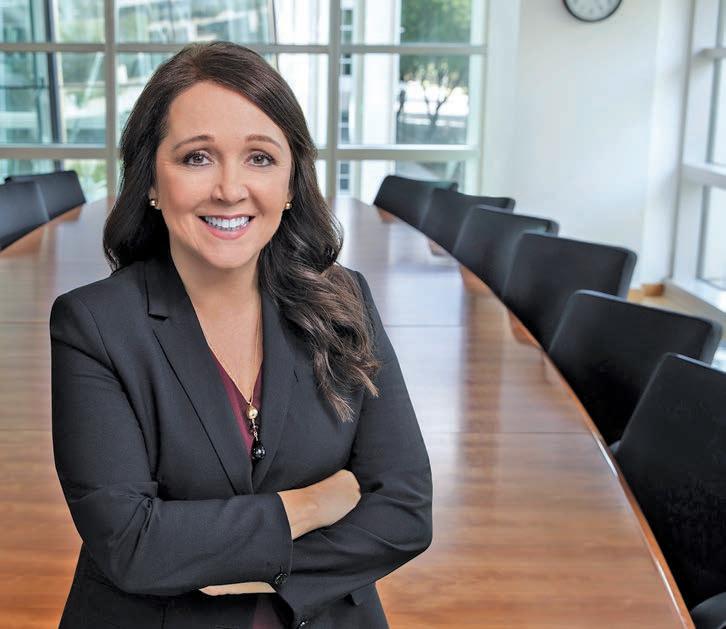
guish the managers (who we are working with) and how they might be using AI — you can use a lot of informational tools, you can use a lot of technology — but unless you have the people with the right behaviors running that company and really pushing for performance and pushing for results, these are just tools that are not going to help you.
Q | Let’s shift to ESG and the anti-ESG movement. BlackRock CEO Larry Fink was very public about ESG last year. Could you talk about your continued work to address climate change risk?
A | Speaking of an area that I have passion and drive, this would be one of the areas for me personally as well as professionally. It is different here in the U.S. I have a lot of relationships outside of the U.S. and these types of political headwinds or “green hushing” and shushing and washing are not as prevalent in those conversations as they are when I’m here in the U.S.
The moment we start letting politics decide how we invest, then we’re all in trouble. For me, we’ve always looked at the E, S and G in terms of risk to long-term capital formation and long-term value creation. We’ve always looked at it that way, from the time we started, we co-founded Climate Action 100+.
Overstrom, adding that with the rm’s move into alternative credit and efforts now to distribute alternative products to retail, and high net worth retail in particular, “we’re really pursuing something that has become kind of the Holy Grail in alternative asset management.”If alternatives hold promise, Mahmud isn’t giving up on the rm’s legacy value equity business, noting that
That was an engagement group; we had like-minded investors, whether they were managers or owners, really working with us around data transparency. And creating that CA 100 benchmark so we had some standardized information to use as we were evaluating those risks.
The only thing now that we believe that we are poised to do is with our SI 2030 plan (CalPERS’ Sustainable Investments 2030), and the enhanced engagement elements, is that we’re going to have deeper conversations with some of our highemitting companies and those conversations are around, ‘Is there an energy transition plan in place?’
And if so, how are they planning to accomplish it? How can we measure what they’re doing, how are they are measuring it?
My belief, based on conversations, is that it is going to continued to be managed. People have just stopped talking about it publicly. . ESG doesn’t have a common de nition so it’s easy to toss that around and dene it as one thing over another.
We’ve always de ned it as, these are long-term risks, we have a duciary responsibility to protect the fund, to protect the members’ assets and our investment earnings on those members’ assets. This is just the next evolution of that, the accountability piece.
the prevailing megacap-driven moment now in markets can’t go on forever.When market leadership broadens beyond those Magni cent Seven growth stocks, the outlook for active managers will inevitably improve. “It’s gravity (and) you can defy gravity for so long … but eventually it catches up with you,” said Mahmud. He declined, however, to predict when that day could arrive.
Q | Marcie, what keeps you up at night? What is at the top of your worry list?
A | Geopolitical risk. We’re a global investor and supply chain issues … I think we all had a bit of a wake-up call about the dependency and supply chains. I would not want to see those become more concentrated. And keeping our own team in a place where they feel supported and can make the investment decisions that are needed to pay these bene ts for a very long period of time. A 6.8% return assumption over all the various market cycles is not an easy feat.
I spoke with my own team this morning about how do we measure whether we’ve got the passion, the drive and the grit, and how do we bring those attributes into the way that we hire in some of these really key positions. We can’t predict the future, but we certainly need to be thinking about what the future could look like and where are the opportunities, where are the threats, and how do we take advantage of one and mitigate the other.
Q | Let’s discuss your grandparents and how they’ve played a crucial role in your career.
A | I grew up in a very small community and had a large family that my mother married into. I spent a lot of time with my grandparents. I essentially spent the entire summer with my grandparents my entire childhood.
My grandfather was a timber faller, my grandmother didn’t work. My grandfather was a decorated World War II veteran. I tell the team all of these things that he used to tell me: ‘You have to learn to take a punch!’ He didn’t mean that physically, he meant you’re going to have to mentally learn how to take a punch.
I recall a lot of the conversations I had with him. They had to survive on Social Security and whatever they were able to save personally. Timber falling is not an easy job on your body, but he got up every single day to take care of his family. At the end of that very long career, he didn’t have an employer-sponsored retirement plan. He had Social Security and personal savings, and they saved extremely well.
But it only took one catastrophic event — and they were living on his Social Security, which did not provide a lot of options. Social Security is not meant to be the sole income provider. I don’t think it’s meant for
But he expressed con dence that First Eagle’s business is better placed now to roll with the market’s punches.
For 2024, “year to date, we are roughly at” overall — still negative on the equity mutual fund side, reecting a dearth of new sales rather than heavy redemptions, but that’s being offset by money raised for alternative credit, high-yield munis
that. It’s going to have (to be) some combination for people to maintain buying power and to really have what we call at CalPERS an identied retirement (source).
Q | What are your thoughts on women leadership overall and what can we do to increase the number of women leaders?
A | We need more women leaders. We started this Pathways for Women event back during COVID-19. I remember throughout the rst year sitting in these Zoom meetings, where more often than I would have liked, I was the only female in the room. You have to have more balance, whether that’s in the boardroom, whether that’s in your C-suite. You have to have balance whether that is gender, whether that is ethnicity, race, LGBTQ. You have to have people with different backgrounds and different experiences and women’s pathways tend to be quite different than their male counterparts. I know my pathway’s very, very different than anyone else who sat in this seat.
You’ve got these people who are motivated, you’ve got these really smart women who just have not had equal opportunity because of the way that a job was written. And women tend to excuse themselves if they don’t feel like they’ve got a 100% of it, where often our male counterparts say, oh, I’ve got 70% of this, I’m good. I’m going to apply for that. We can remove ourselves from consideration naturally. We need to provide better support networks.
Q | I ask this of all of my Face to Face profiles: What is the untold story of CalPERS?
A | We are different. I know a lot of our stakeholders, sometimes our board, our members like to compare us to our sister fund (the California State Teachers’ Retirement System). That isn’t always a direct comparison. What happens at CalPERS is really quite different. This public nature, this transparency. We appreciate scrutiny. I have no problems interacting on why we made a business decision, but I’ve yet to nd organizations that have the same level of personal attention on employees who work here. I’ve not seen that anywhere else, and that does take its toll, it takes people off the game, makes people a little more afraid of risk-taking.
The story is we’ve got this amazing group of employees here who are
and separately managed account products launched in the retail space over the last year or two, Mahmud said.“I feel like our rm has turned a corner in terms of managing our ows,” he said.
Meanwhile, the prospect of Blackstone and Corsair, eight years or more into their partnership with First Eagle, eventually exiting — whether through an initial public
very much focused on our mission.
There is a bit of an untold story about what it means to be at CalPERS vs. essentially any other institution anywhere. The turnover has simply been with the CIO position. I’ve got managing investment directors in the investment of ce. I don’t know what their combined tenure is but it’s over 100 years, probably. There isn’t this chronic turnover in the investment of ce, there is this chronic turnover in the CIO. I think we really need to think about the attribution to that and nd ways to help support that CIO position in the CIO community, but also the communities that operate around us.
Q | And what is the untold story of Marcie Frost?
A | I’ve been criticized because my path is different. I don’t have a formal college degree, but I had this incredible career in Washington state. I spent 30 years there before coming to CalPERS. I started as a typist. I took typing classes in high school, took shorthand classes in high school, I worked during high school. I forfeited all my electives, so that I could go work in this real estate of ce. Just working from being a typist to, in 2013, the incoming Gov. Jay Inslee appointing me to be on his Cabinet.
He didn’t do that because I was a typist. I had worked other positions by that time, and I was actually at the retirement system by that time. People wonder, ‘How did she do that? Why did the CalPERS board hire this person who doesn’t have a formal college degree?’ What I heard from the 13 who hired me, it’s the combination of being focused on the members; it’s how I look at team engagement and really supporting our employees, being ef cient.
We’re a trust fund, we have to be ef cient with the assets that are entrusted to us, being that reliable partner, and these are things I’ve told the team from Day One. Being a reliable partner to all our stakeholders, being accessible. They may not always agree with us, but we’re going to be accessible to them. We’re going to share ‘our why.’
I don’t think this job is about me. It’s about me to the extent that it has my name as its head, but the organization, there are so many wonderful stories about our team and the people who work here and why they work here.
That’s why it gets me up in the morning to come to work. n
offering or a sale to a strategic buyer — shouldn’t trip up the rm’s momentum, Mahmud said.
Those shareholders’ highest priority is to “sustain and build upon our momentum, which we believe will maximize shareholder value for both existing and future owners,” he said, adding “there are no plans to change our strategy or disrupt our momentum.” n
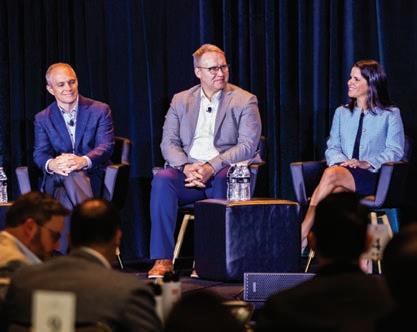






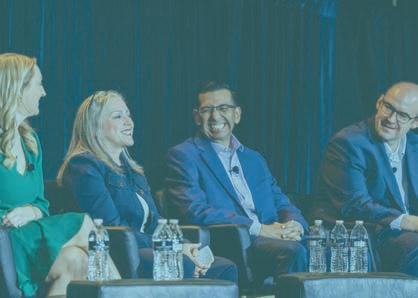




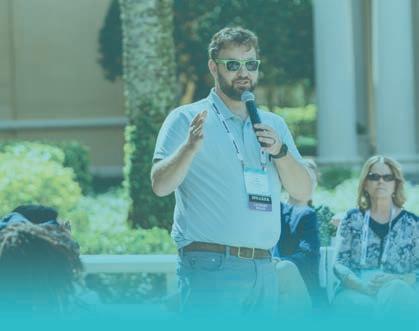



We extend a heartfelt thank you to our Sponsors, Advisory Board, Speakers, and dedicated Attendees for their invaluable contributions in making this year’s DC East Conference a truly unforgettable event!

